There is one matter we need to discuss and for the life of me, I have no idea why I have not brought it up to this point. Ballrooms. Private ballrooms. Specifically, of the third floor nature.
It is astonishing to reflect how many people, outwardly respectable people too, stumble through life without ever looking upward in hopes of seeing a ballroom window. They go about their way with, apparently, clear conscience. They smile impassively as they ride those scooters down the sidewalk. They merrily pedal their bicycles along the road. Now mind you, I am sure these folks are just swell in person. Their mothers would attest to this belief. Or like Mr. Cassette, there are those who choose to focus and fuss about unusual gardens they have come upon during long walks and they would like to tell you all about the butterflies they saw, if given the chance interruption in conversation. And all the time, if one only knew it! There is a terrible secret they are harboring—these people are NOWBs: Not Obsessed with Ballrooms. If you, gentle reader, are blank to ballroom window hunting yourself, it is to be hoped that you will do something about it without delay. And this very article may help you.
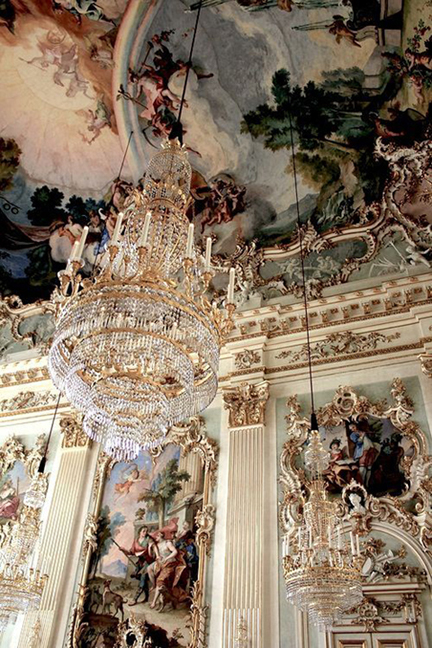
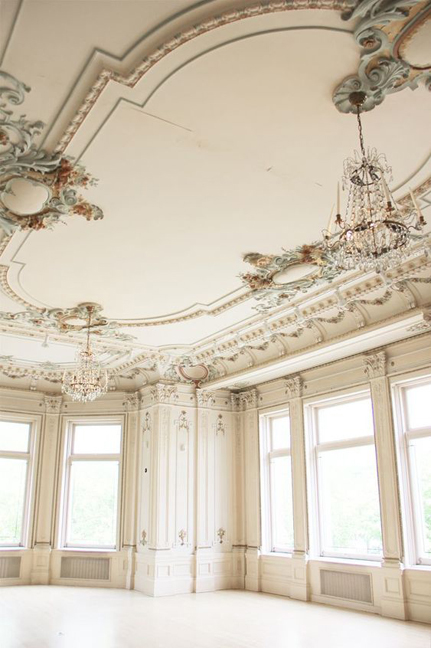
I have a detective friend whom I became acquainted through My Omaha Obsession. She is able to say, “I have a ballroom in my house,” although she probably does not often make such declarations in public. This is Omaha after all. As lovely as she is, one would never know she has a Third Floor Hush-Hush behind closed doors. You see, Rhonda Stuberg and her husband, Wayne, own the Gottlieb Storz Mansion at 3708 Farnam Street in the Gold Coast. As an aside, if I held the keys to this showplace, everyone would know my little secret byway of the muted tone wink of my perpetual tiara, my formal gloves and undying full-length beaded gown, even at the grocery. At the very least I might don a daily feather mask like one of Truman Capote’s Swans at his infamous Black and White Ball. Regardless I just so happened to know of the rumored ballroom on the third floor of the Stuberg’s lovely Storz Mansion. I approached Rhonda about the idea of the private ballroom series and I thank my lucky stars she was game.
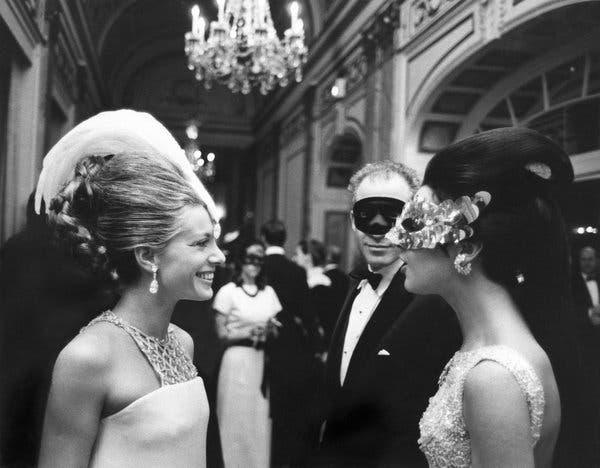
For those that require quick, bite size Internet reading, here is your synopsis: In my pursuit to track the short-lived history of residential third floor ballrooms, I reached out to the owners of the Gottlieb Storz Mansion. Built for the beer magnate of the Storz Brewery Company, this mansion and its ballroom once hosted the legendary parties of Old Omaha. A very brief history of the Storz family is highlighted as I shine my detective’s flashlight into the family’s ballroom. Did Adele and Fred Astaire really launch their dancing careers in that storied hall? You are invited to the dance.
The Obsession Begins
I don’t remember how old I was when I first learned of the third floor mansion ballroom sensation. It was possibly from some fantastic interior design showcase tour Mother of Miss Cassette would take me to, back when Omaha used to offer up fantastic mansion tours. I am just sure of it…or was it that American Castles show my grandmother used to record for me? There were homes in Omaha built during the Victorian and Edwardian periods that featured their very own ballrooms, usually on the third floor or upper most floor. These luxurious private halls once hosted the legendary events of the privileged class in an era before the fashionable set wanted to carouse publicly at hotels and country club soirees.
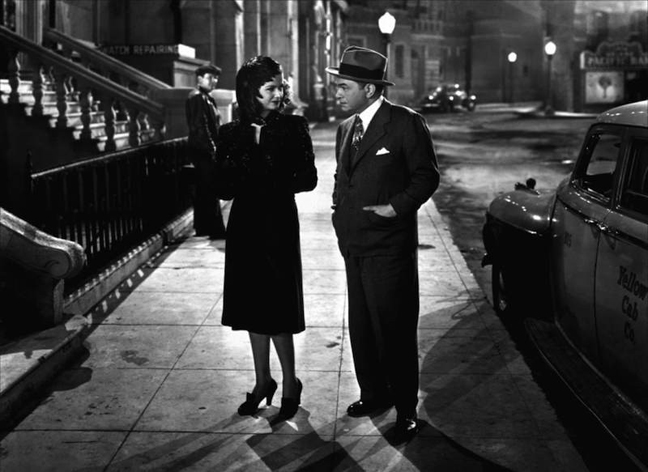
Later I was lucky to live in the Gold Coast neighborhood both north and south a number of times over, whereby I resumed my childhood lessons. Lowly renters that we were, we kiddies knew This Was The Place To Be and didn’t need neighborhood street banners to market the obvious. (I suppose that was needlessly snotty and I will refrain from here on out.) Undeniably lovely, my Gold Coast apartment days really only served to reinforce this architectural neurosis of Bedevilment By Ballrooms. (See B3 in the book of diagnostic classifications.) Nighttime wandering from our various friends’ apartments back and forth, was made all the more lively by drinking (in the beauty), Looking Up and assessing the higher windows of these sprawling showplaces. Again and again I had moseyed into the trap of obvious machinations. Did the ballroom span the entire length of the dwelling or was I observing a dignified man’s third floor retreat? Perhaps the servants’ quarters? Was it really a dancing hall, a reconfigured penthouse suite or was it just an attic with deceiving leaded glass windows? Dilapidated, haunted or pristine? Silly me. I was coaxed along. Lured into the dream trap repeatedly, I could only conclude that I liked the torment. I imagined being on the Other Side of Ballroom Window, drawing back the interlined pinch pleat curtains in a sweep of unusual grace, to gaze down upon the whippy, little character on the walk below, clothed in a mini sailor dress, holding binoculars and an opened bottle, scanning upward, with mouth agape. It was and remains one of those continuous encores that give to life a mirror, a preoccupation and a sense of haunting thrill.
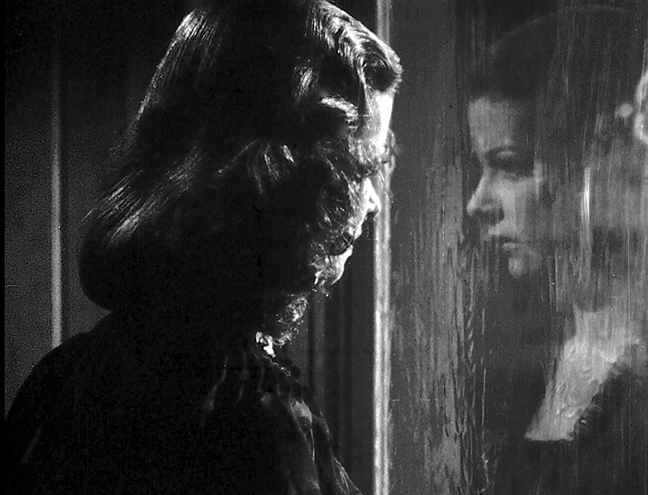
My Process
There is one more pesky issue we must address before we plunge headlong. There were many times in the writing of this article that I began burrowing into dark, webby tunnels of the Gottlieb Storz family, their houses, the businesses, the rumors. Finally I had to commit to putting away my little hand shovel, pail and midnight oil as this piece was intended to be a short, fun exploration of this great family’s Ballroom Only. I am sure I will wander into just a few of these previously dug out Storz rabbit holes, because I find them fascinating but I will attempt restraint for once. Let’s not make this a habit. Rest assured, I have put in order all of my local Storz research for another day.
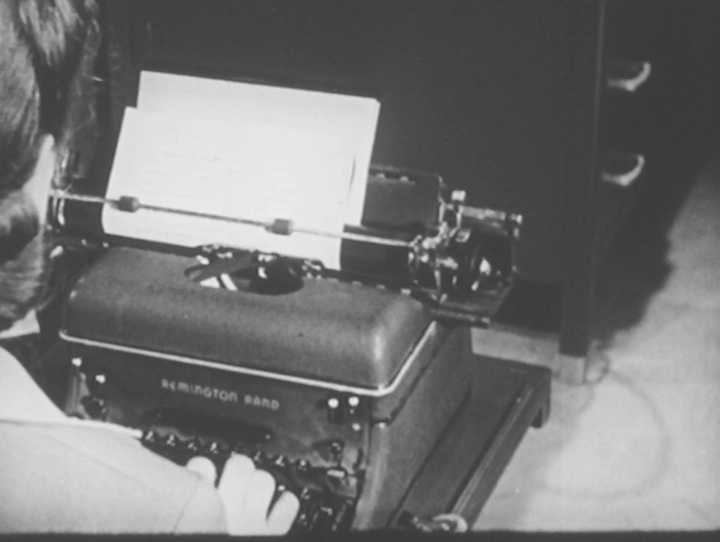
Brief Introduction to Ballrooms
The idea of these old money residential extravagances has always sent a glorious shiver. The preposterous, formal aesthetic of it all…my goodness. I suppose I first spied a dumbwaiter and butler’s pantry when I was very young at a family member’s Thanksgiving. At this glorious gathering there was also some fashion of complex passe-plat, which seemed quite ornate with a series of puzzling inner doors to memory. I am still not truly sure where the holiday turkey and stuffing came from. Servants’ quarters, which by then had become rental apartments, and gliding pocket doors were luxuries I had investigated as a child at my grandmother’s home, inherited from her parents. But what of cedar-lined cold storage for one’s furs, an ironing room, an underground cellar for wine and alcohol storage and private ballrooms? How exhilarating and how often?
Private ballrooms came into vogue during the rise of the Victorian Mansion from the 1880s through the Edwardian period (1901-1910), ending new residential ballroom construction in and around 1920. These sumptuous amenities were limited to only the most prosperous of families, those perhaps wanting to best the ol’ So and Sos of the West Farnam District. The way I conceive of it all, a grand ballroom, dance cards and string quartets became a cultural tool–a societal device that could solidify a well-born standing as well as aid in the leverage of newly upper class hosting requirements. Society entertained at home in those days, be it an intimate dinner party or an extravagant ball. But more importantly a top-floor ballroom, packed to the gills with elegantly dressed warm bodies (long before air conditioning) dancing to the best live band in town, must have been a whole lot of fun. In fact, legendary.
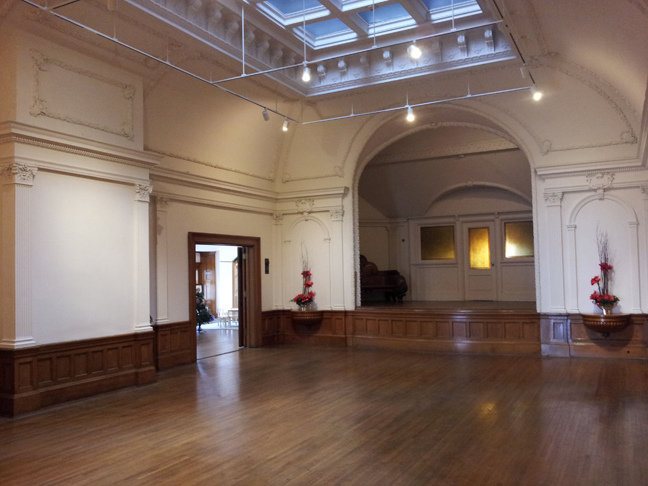
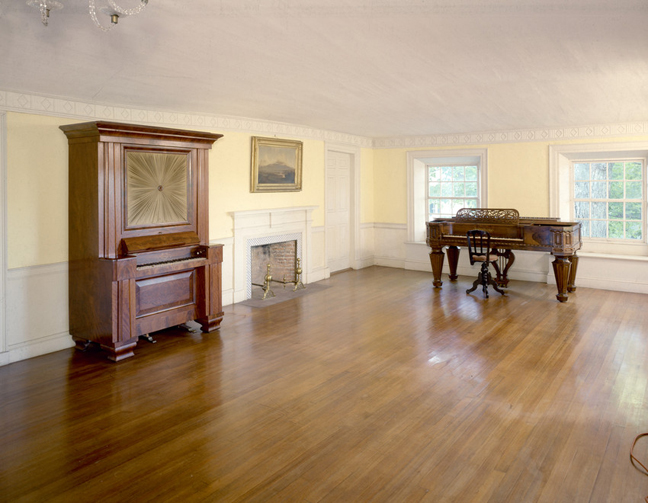
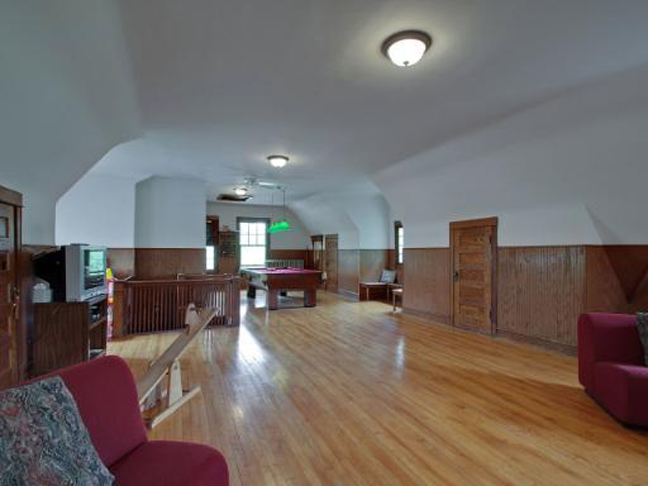
From what I have estimated, the well to do of Omaha tended to build smaller, modestly scaled, private ballrooms. I base this on the fact that our “mansion” scale, even in the days of local tycoons upbuild of now torn down mansions, has traditionally been much smaller than that of other cities. I believe this local Slight Building trend is simply a byproduct of our practical, non-showy, rural genes. Slight as they were, I was compelled to look for signs of top floor ballrooms in the Gold Coast area—proper windows and a high roofing pitch being key elements. Did I see a candle gliding by the dormer?

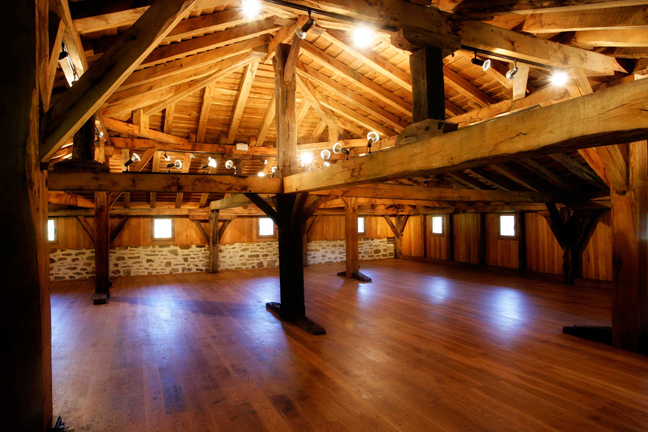
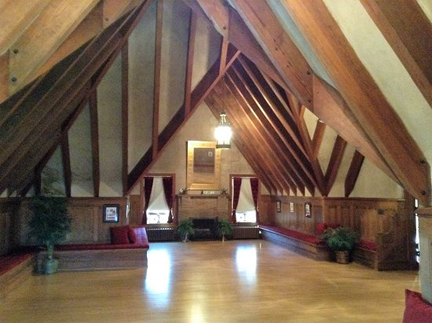
A functional ballroom was large, uncluttered and generally absent of furnishings altogether with ultimate dance-ability in mind. Small, lightweight, what my grandmother called “ladies’ chairs,” might be brought in and easily re-arranged on the edges of the dance floor or in some cases, there were built-in benches. The floor was customarily highly polished hard wood in these early days, sometimes of marble. The interior treatments were generally minimal. Minimal columns, with high or vaulted ceilings, sometimes with flourishes in wood embellishment, large windows, chandeliers or friezes. There were often times a stage, essentially a slight lift off the floor in a corner or front of the room for an orchestra, stringed quartet, musical or spoken word event, dependent.
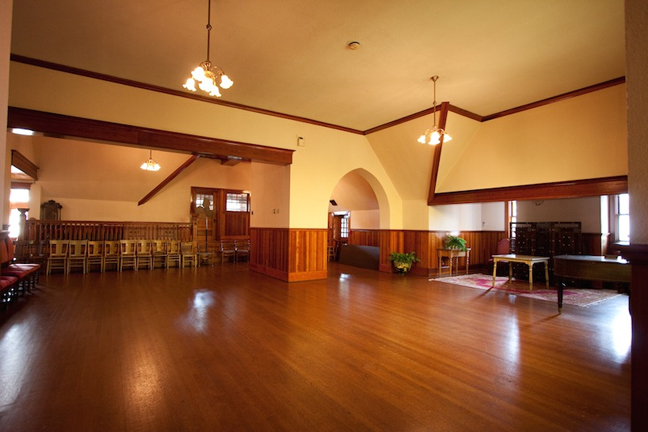
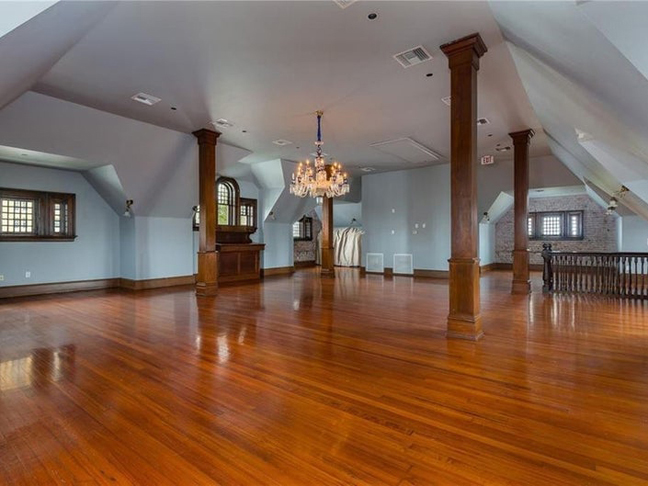
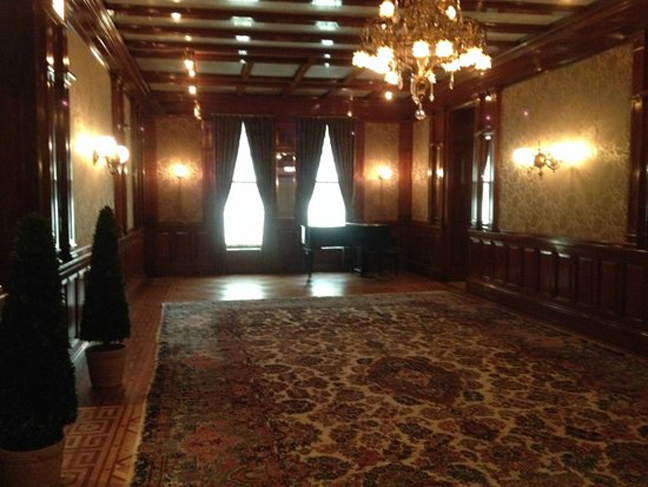
By the 1920s, building a residential ballroom was woefully outmoded. The young posh set was beginning to enjoy the advantages of newfound luxury apartment living. Wealthy people of all ages were also transitioning to socialize outside of their homes, communing at hotels, private and public clubs for drinking and dancing. This was also the rise of the large, glamorous hotel, which also offered ballrooms and orchestras. In this manner, the toffs could show off their finery and swells could rub shoulders with the swells and social climb all the more. By the 1930s beautiful Omaha hotels such as the Blackstone, Rome, Paxton and Fontenelle offered ballrooms for local celebration.
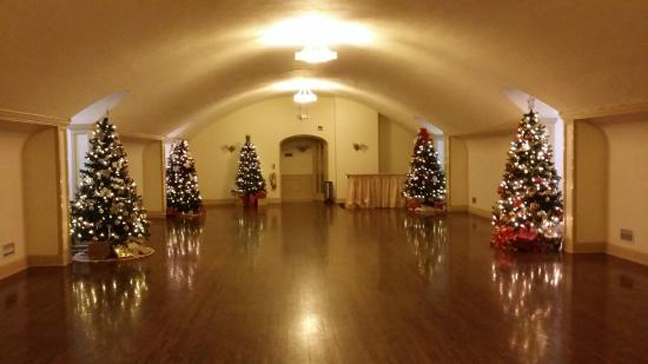
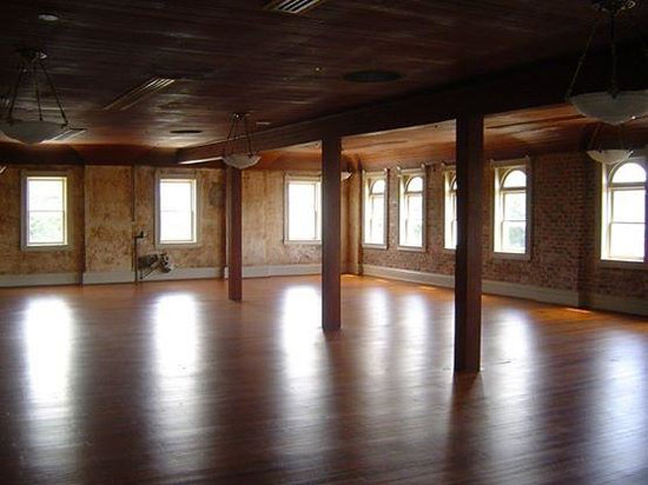
But what to do with these large, underused private ballrooms? I know many of these mansions have long since been demolished. But what happened to the ones that survived? I longed to know. Broken up into apartments? Outfitted with a mother in law’s kitchen and bathroom? A personal gym? A roller rink? A painting studio? The best playroom? I do dream that this can become a series and that more Omahans with residential ballrooms will share their secrets with us!
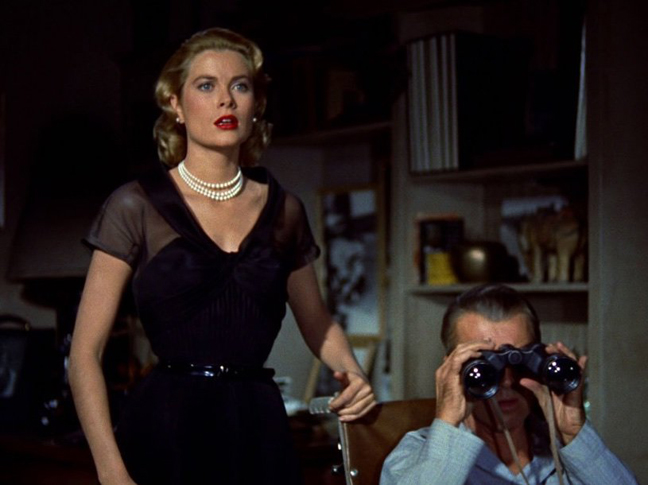
A Few Words on West Farnam
B. F. Sylvester made clear in his fantastic little book West Farnam Story, “West Farnam denotes a district, not the street.” Yes, it would become confusing when many of these grand, solid residences were built on the Farnam Street thoroughfare—“west” compared to living downtown and just north of downtown where the wealthy had always built. Of course none of these Turn of the Century, solidly built structures on Farnam Street are left standing, except one. Which just so happens to be our preoccupation today. Previous to the Blackstone Hotel (302 South 36th Street) being constructed in 1915, the district from Davenport south to Jones Street to 32nd Avenue west to 40th Street had been called the West Farnam District—sometimes used interchangeably with the Gold Coast District. Now the Gold Coast Mansions also extend north of Dodge into what is also named the Joslyn Castle, Cathedral and Duchesne neighborhoods. I touched on these curious labels and boundaries in my https://myomahaobsession.com/2016/10/18/bertha-yost-offutt-and-the-mysterious-gold-coast-mansion/, https://myomahaobsession.com/2016/07/26/brothers-lounge-and-the-case-of-the-vanishing-mom-and-pop/ and https://myomahaobsession.com/2016/10/31/the-secret-of-burt-street/ investigations. If you haven’t yet read these cases, you’ve got a lot of fun in store. By the way, the Blackstone Hotel was still Herman Kountze’s east pasture in those early teens and Omaha’s barons and businessmen, “The Heavy Respectables” as a local society photographer once named them, were contented to live in a posh neighborhood with only two names. With the addition of the Blackstone Hotel, apparently adding a third denomination: the Blackstone Neighborhood, although we little renters never called it that in all my apartment years.

2019 Google map image borrowed from Google. The Storz Mansion at 3708 Farnam is denoted by the large red symbol.
I knit away about the Gold Coast and West Farnam Districts because this would appear to be the site of the majority of ballrooms, at least that are still extant. North Omaha, particularly the grand North 16th Street strip, which was then called Sherman Avenue, surely boasted of ballrooms in its day, as did the mansions found just west of the heart of old downtown Omaha, also on South 16th Street, long since razed. The fine homes along South 10th in neighborhoods around the old St. Joe’s- Grace University area most likely have hidden top floor dancing rooms. Of course South Omaha is harboring private ballrooms as well. We must find them all, detectives!
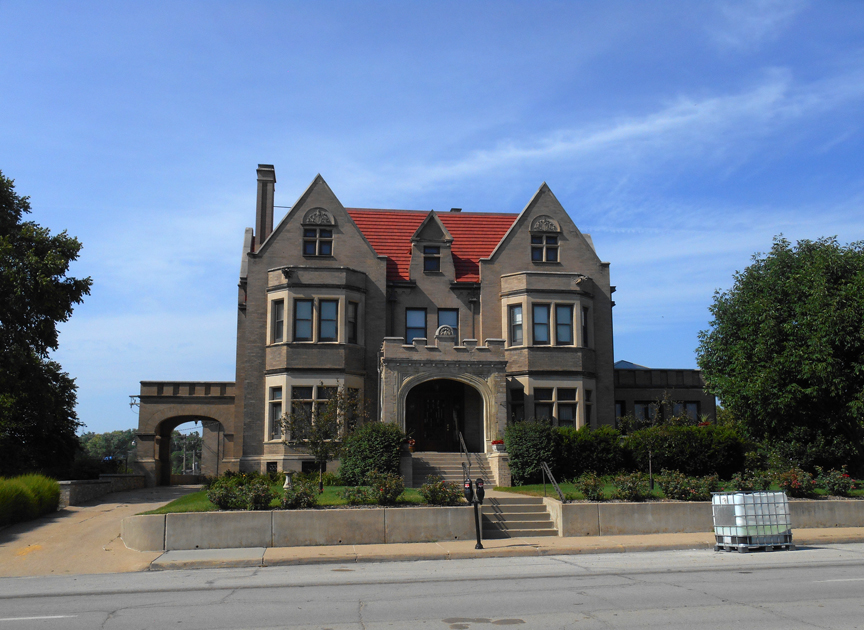
3708 Farnam Street
My Ballroom Visit
Rhonda Stuberg welcomed me into her home at 3708 Farnam on the northwest corner of 37th and Farnam. This was actually my second visit to the home; the first was a strange tour with the wonderful Art Storz, Jr., an acquaintance of my father’s when he wanted to rent me his carriage house. More on that at a later date…In 1974, the Storz Mansion was placed on the National Register of Historic Places; it was also designated an Omaha Landmark in 1982. A clear brush with celebrity, I won’t dillydally with the sheer internal squealing of driving under the Storz porte-cochere and dizzying visual spectacle of the first floor tour. But my word. Did I dream it? We’ll revisit this in my upcoming Storz investigation. But let us get underway. Rhonda led me to the grand staircase. A fine marvel in and of itself.
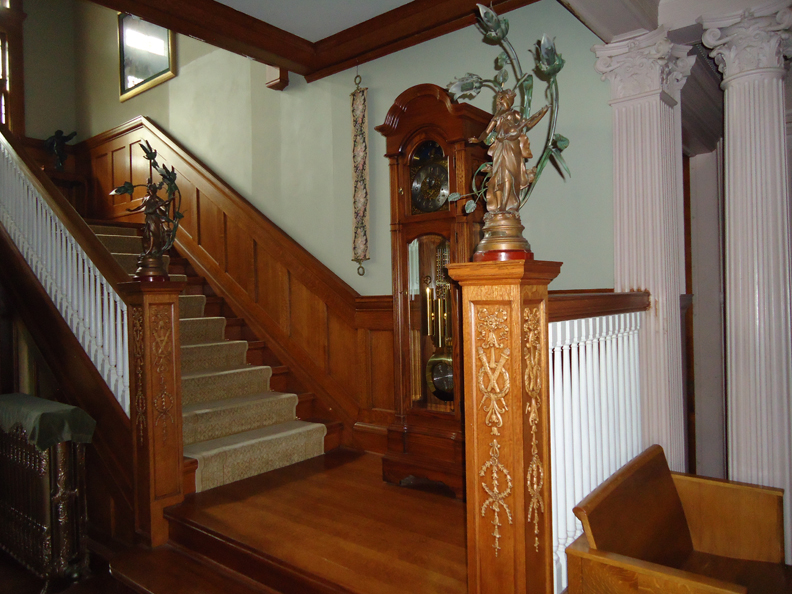
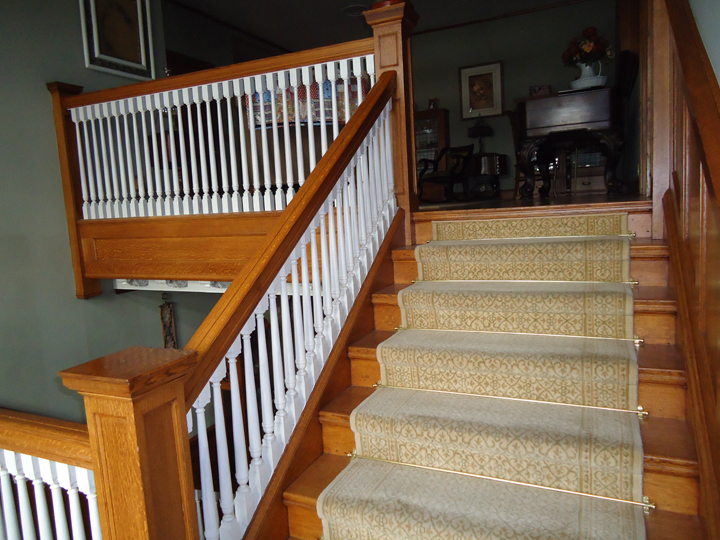
Now Rhonda, being of a down to earth type, had forewarned me that the Storz Ballroom was not opulent by any means. I understood her intention was not to lead me on, thinking I was going to a Cinderella Ball in Vienna but I said to myself, “Let Miss Cassette be the judge of this.” After all, how often does one get to tiptoe around a grand staircase in glass slippers and an updo, wandering up back servants’ stairs to a private ballroom? Let us not knock the wind out of the collective sails of the little people! We are all gathered here to dream.
Once to the second floor, I found countless bedrooms, surrounding a sort of informal sitting area, larger than my whole 1941 living room. Some of these bedrooms are occasionally offered for rental on Airbnb. I was surprised, and commented to Rhonda, when I found I wasn’t looking in a mirrored hallway but rather, another endless corridor of bedroom doors. Keep in mind this is a 27 room mansion with seven fireplaces. Gulp. Another stunner was how very silent the residence was for being situated on now busy Farnam Street. An understatement, but they don’t build like this any more. Amazing. We would take a turn and yes, I did get spun around when we walked to another staircase on the western side of the home, one that would take us to the third floor.
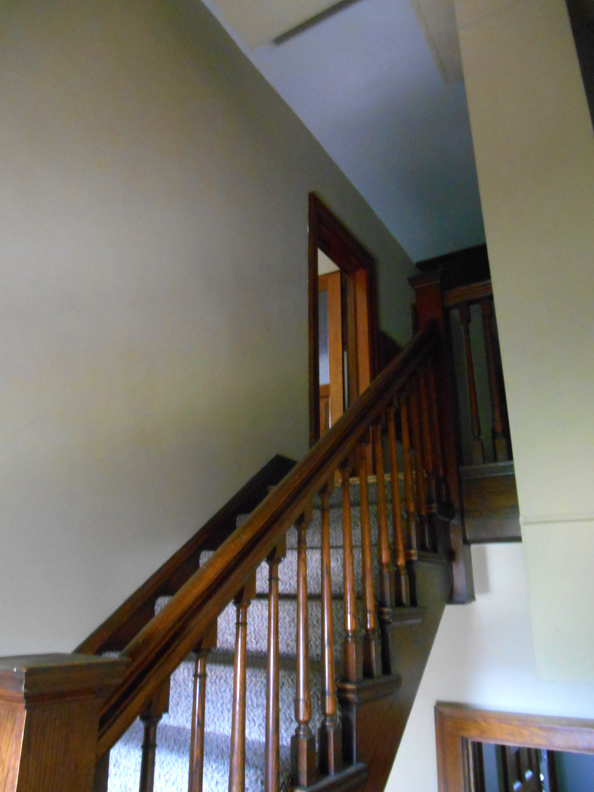
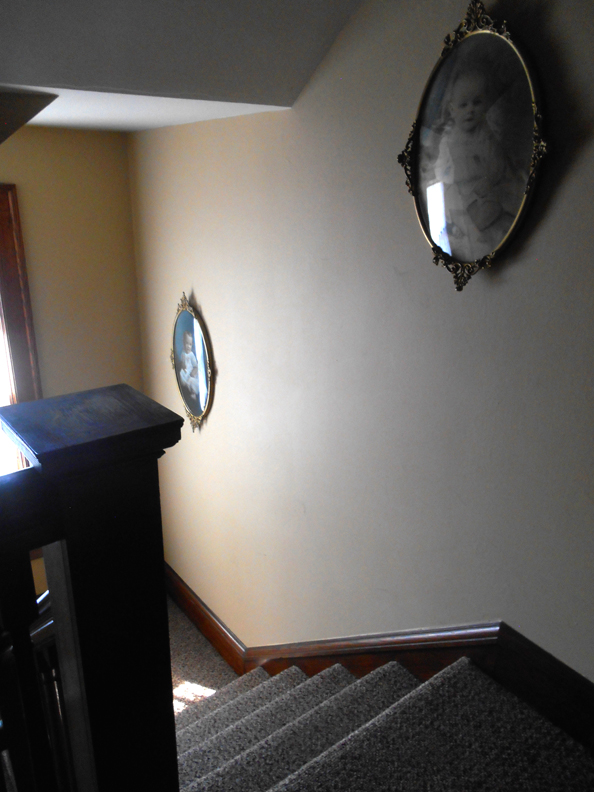
Mansions required a large household staff to keep them running in tip-top shape. As an aside, when the Storzes moved to West Farnam, they typically kept a staff of five on the payroll. Servants were expected to stay out of sight and separate stairs, usually off the kitchen or butler’s pantry would do the trick. The Storz back staircase is no different: it is separate and led to the top floor, as well as extending down to the kitchen. (How did they get to the basement? I forgot to ask!) Rhonda and I discussed the curious nature of the design, being that the formal stairs did not connect to the third floor ballroom. She believed that early guests to the Storz Mansion would be welcomed into the party on the main floor where they would be offered drinks, food and lively conversation. When it was time for the dance, they would most likely be escorted up the grand staircase to the second floor. Once there, they would be shown another staircase, a simpler set, thought of as the servants’ stairs. In that manner, an unsuspecting guest would not have to pass the kitchen where the domestics were toiling. These backstairs on the west side, led up to the third floor, where the ballroom was found, in addition to sharing a wide hallway with the spacious third floor servants’ quarters. In some circles this might have been seen as gauche but again, Omahans are practical by nature and this just seemed to be an economical use of space to me.
From one my very favorite Omaha writers, Margaret Patricia Killian, in her book Born Rich: A Historical Book of Omaha, a special nod to those behind the scenes: “For the owners of the mansions, there were social gatherings in their own lovely parlors and the third floor ballrooms. These gatherings were made possible by the services of capable and loyal servants.”
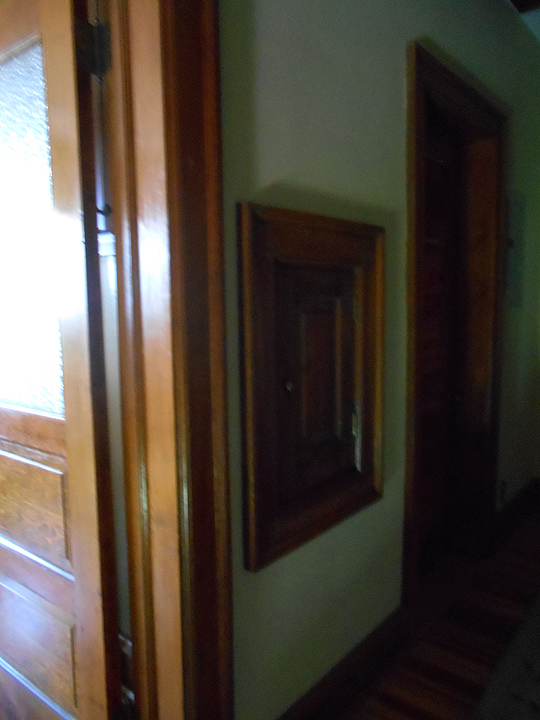
I was delighted to see the dumbwaiter in the hall outside of the ballroom; a mini elevator used by servants to carry dishes to other floors. In this case I would guess that in the party days, the Storz’ servants were replenishing bottles of alcohol and clean glassware while shuffling used glasses and finger food plates downstairs without running into guests. People did not ride in dumbwaiters, although Rhonda informed me that the Storz relatives have reported they remember putting the poor family dog in the dumbwaiter and sending him on a great voyage from floor to floor.
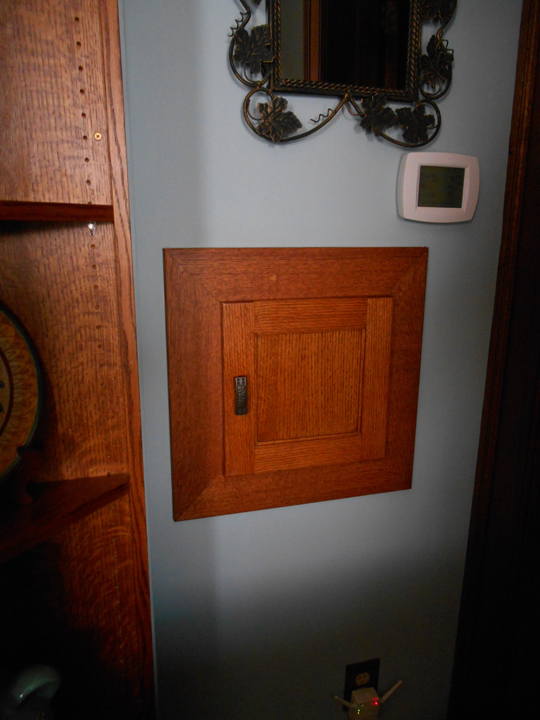
She also confided she had made the framing and doorway to the first floor dumbwaiter smaller when they updated their kitchen.
Rhonda would open up the portal to the grand ballroom. The door didn’t even squeak! And there it was, the Storz Ballroom. At once it was expansive, airy, cool and spotless. To find it absolutely clear of outdated home exercise equipment, underused craft materials, emptied of storage totes and remiss of an ironing board was the Pure Luxury I had dreamt of. To have so much square footage in one’s mansion that one can leave one’s ballroom Empty was the ultimate measure of decadence! Or maybe it was just the mark of a tidy housekeeper? No matter…The Storz Mansion is in solid, excellent condition and the third floor ballroom was no different. Did I think I would find creaking floorboards or a wafer thin trampoline flooring once in the dancing hall? The ballroom spanned the entire length of the southern front-facing, Farnam Street side of the residence, absorbing over half the size of the third level. It was much larger than I had anticipated. I found shiny wood floors, a must for a good dancing room. The ceiling was surprisingly over twelve feet high. It was an incredible sight, breathtaking but functional. Not over indulgent.

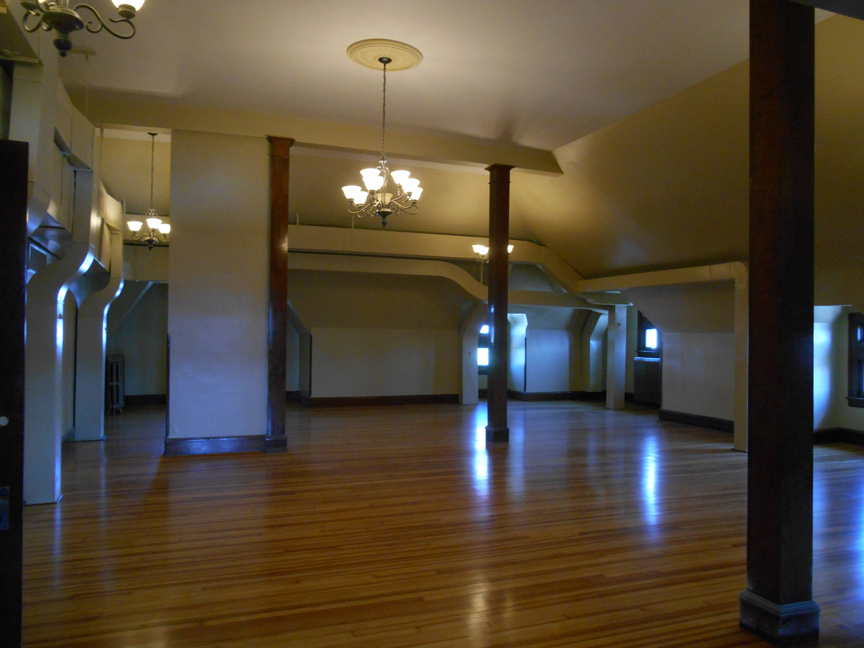

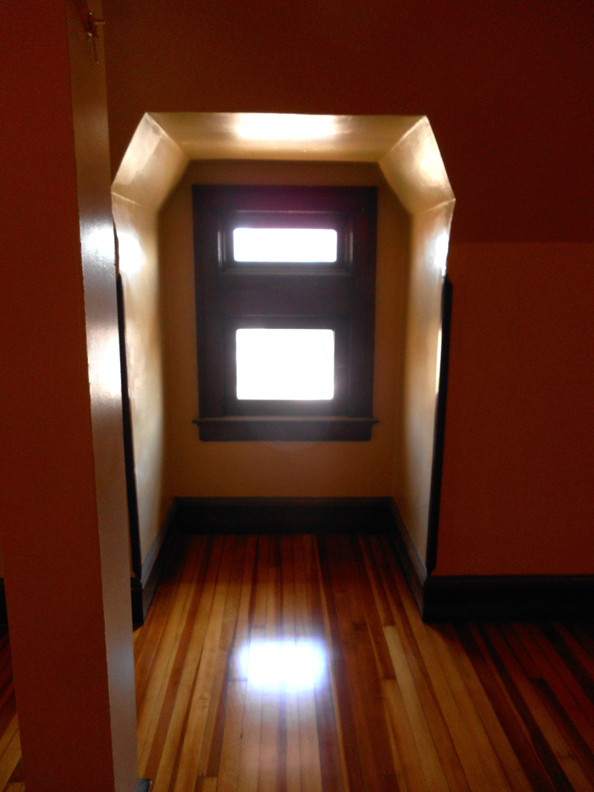
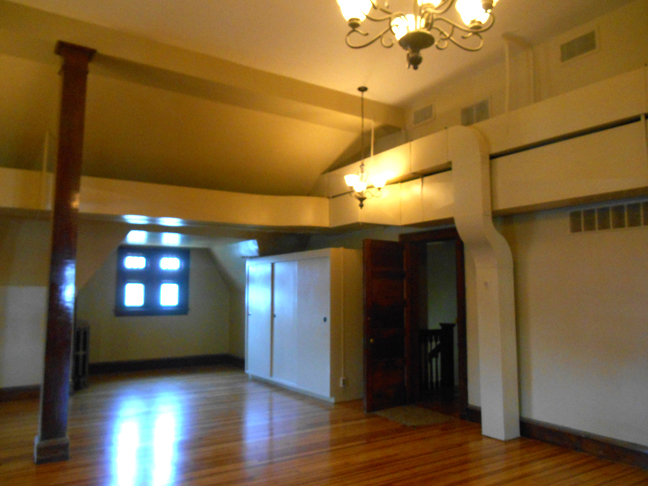
I spied a wardrobe most likely for guests’ coats. I wanted to peek inside, hoping for a chute to dreamy otherworlds but I didn’t have the courage for fear the wardrobe is where Rhonda kept her quilting storage or her old college papers. I began obsessing about the mirrored window experience–wanting to look down and feel the sensation of watching those on the sidewalk below, (who are often me)—wanting to know how it felt on the inside of the window. I commented to Rhonda something to the sentiment of, “Can you imagine in the early 1900s looking up to these ballroom windows when the Storzes were having a dancing party?” Delightful to imagine that warm glow. There were no plaster friezes, large, elegant stained glass windows, no crystal chandeliers or coffered ceilings. But the sheer volume of it. There were lovely, darkly stained yellow pine pillars throughout the room that added character and a sense of structure. As far as having a ballroom within one’s mansion, I found the Storz Ballroom quite sensible and unassuming, if that is possible. It was also fantastic and a chance to feel endless history. When it came to the Storz’ beautiful indulgence, it was devised with a Nebraska Hard-nosed pragmatism and I adored it all the more.
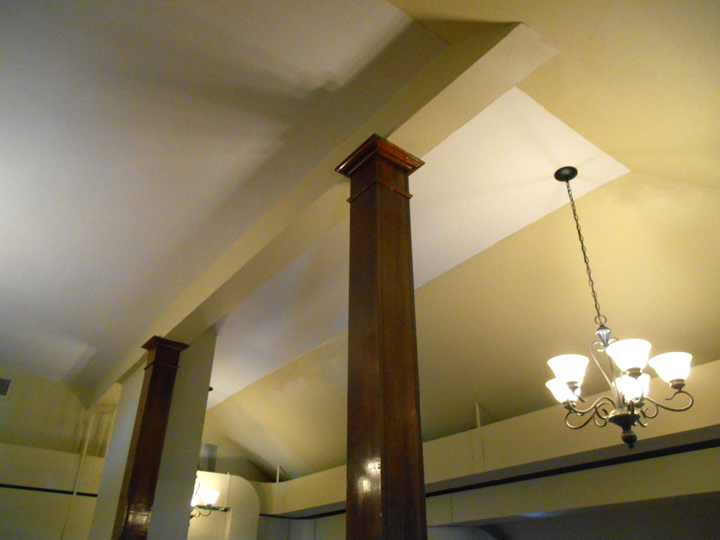
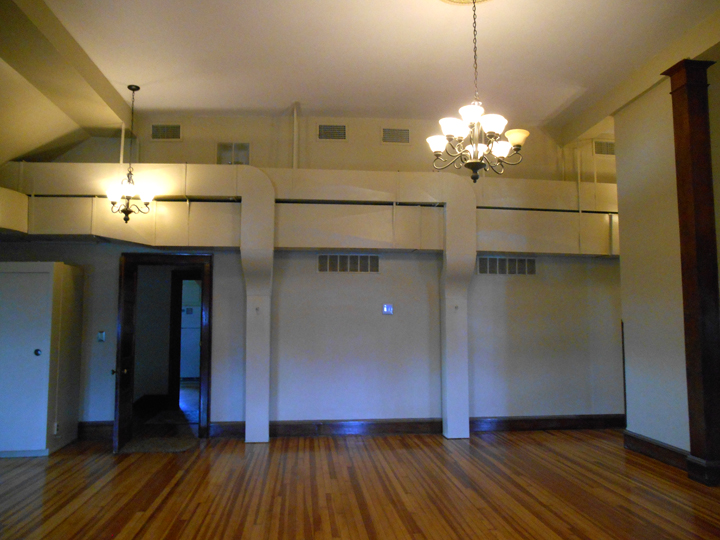
For their part, of which was no small task, the Stubergs patched the walls, repainted, sanded, patched damaged portions of the wood floor, sealed the floor and updated lighting controls and fixtures. Like the rest of the mansion, the walls had thick muslin underneath and a portion had been badly damaged. See Rhonda’s “before” photos to get an idea.
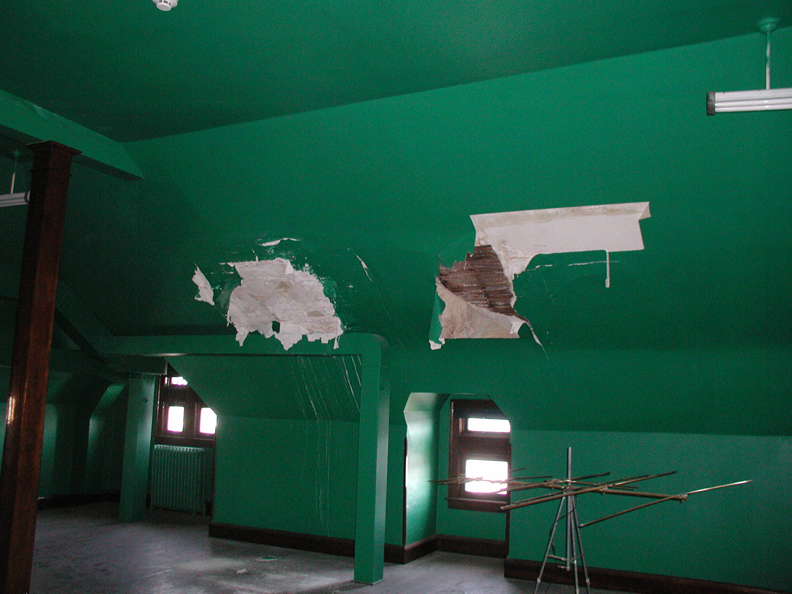
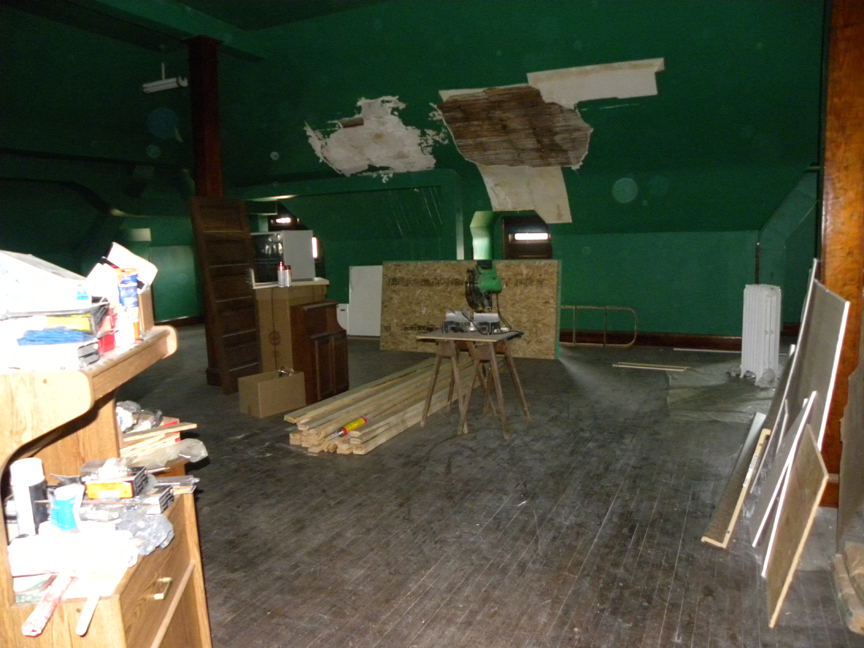
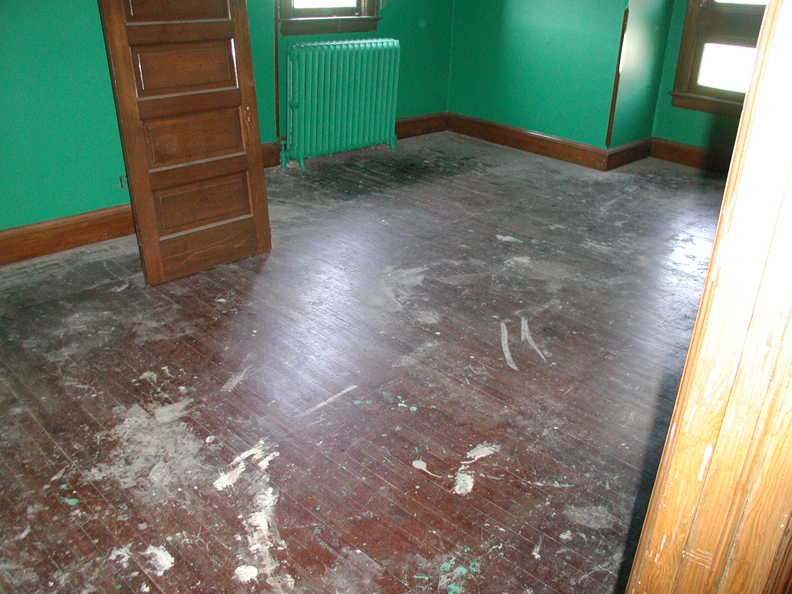
Art Storz, Jr. had painted the walls a dark, grass green and the pine floors held a very dark color that apparently, was not stain. According to Rhonda, “It felt creepy. The floor had not been finished since the home was built. They were mucky, dirty brown floors.”

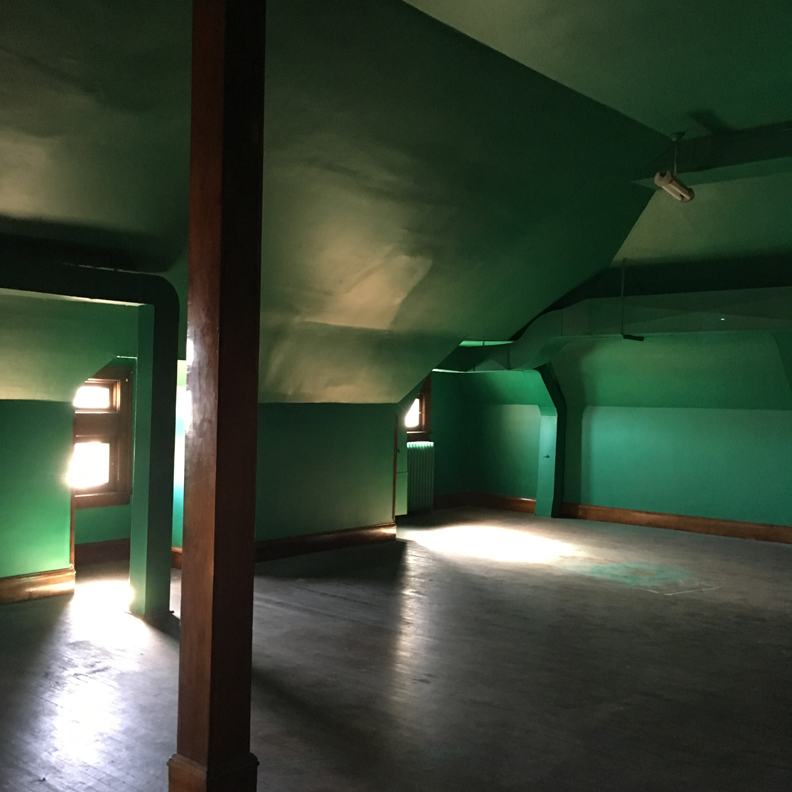
The flooring was yellow pine, which the Stubergs were able to refinish without staining—“just coated it with polyurethane.” Likewise the ballroom lighting consisted of “three long fluorescent lights,” replaced with the multiple contemporary chandeliers you see in the photos.
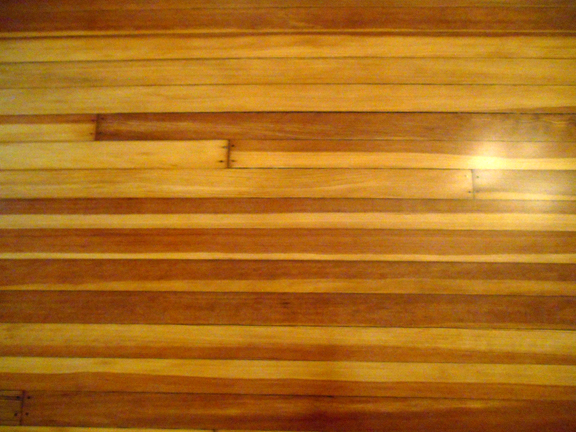
How the floor looks today.
Obsessive Notes on Pine: Pine is technically considered softwood, not ideal for a ballroom due to dings and dents. I am assuming that pine trees were most likely used for the Storz’ ballroom floor, as they were plentiful and therefore inexpensive in those days. Hardwood flooring, from my research was optimum for a residential ballroom but the Storz’ yellow pine is considered the hardest of the softwoods. It obviously has done the job and remains gorgeous!
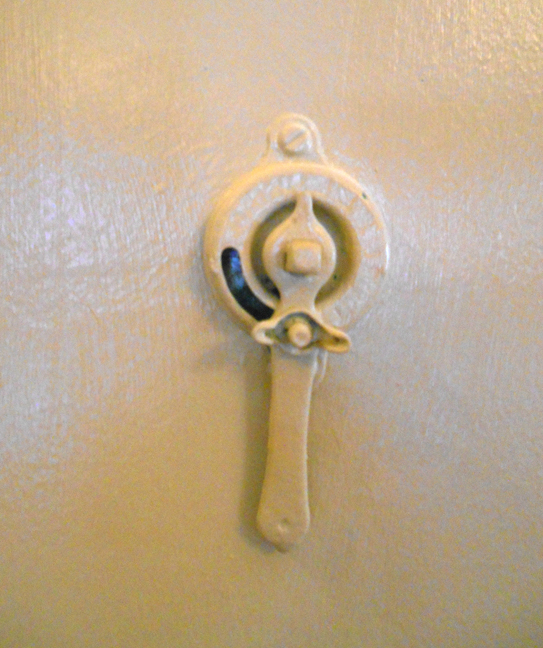
I was fascinated by the complicated design of the endless exposed ducts throughout the ballroom and vintage HVAC controls. Why? I would dig up that the home’s central air-conditioning was installed in 1948.
I looked for a potential musicians’ gallery—a small, raised stage area, overlooking one end of the ballroom. I thought I had one spot picked out that looked like it had been remodeled or the flooring altered. It was on the west side of the room and I daydreamed it was out of the way of the dancing crowd. Rhonda denied finding any sort of stage when they bought the home.
New Breath of Life
Since the Stuberg’s stewardship, the ballroom has once again risen to the occasion of grand hostess. Nick Huff, co-owner of Hutch in Midtown Crossing approached the Stubergs about utilizing their ballroom for a pop-up dinner party idea of his. 50 people came for the plated meal and ate by candlelight in the darkened ballroom, pre-renovation. What a special, one-off night that must have been. Rhonda generously shared these intimate images from that night. If I didn’t want a ballroom before, these pictures gave me new delicious ideas!
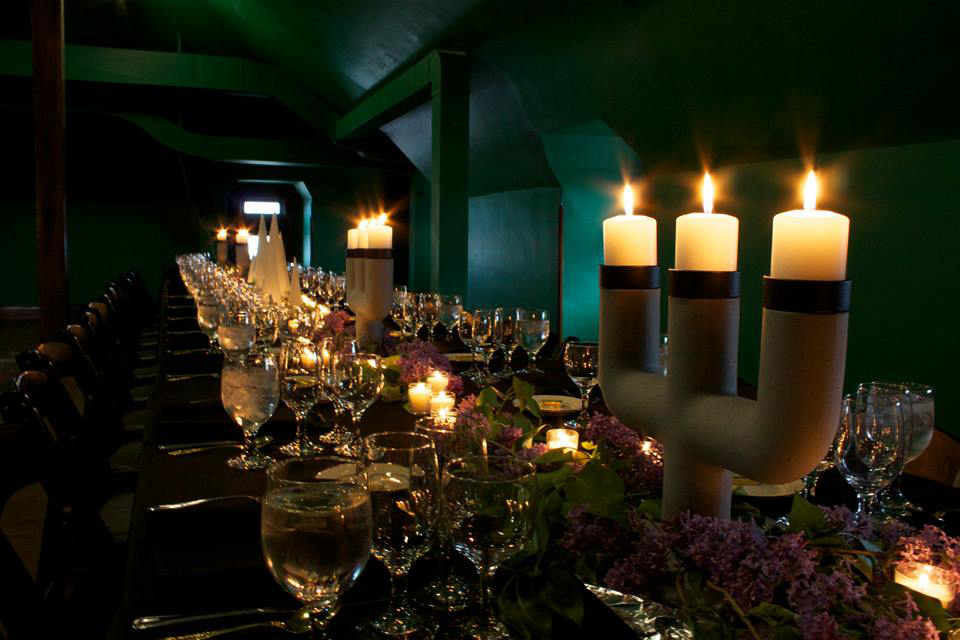
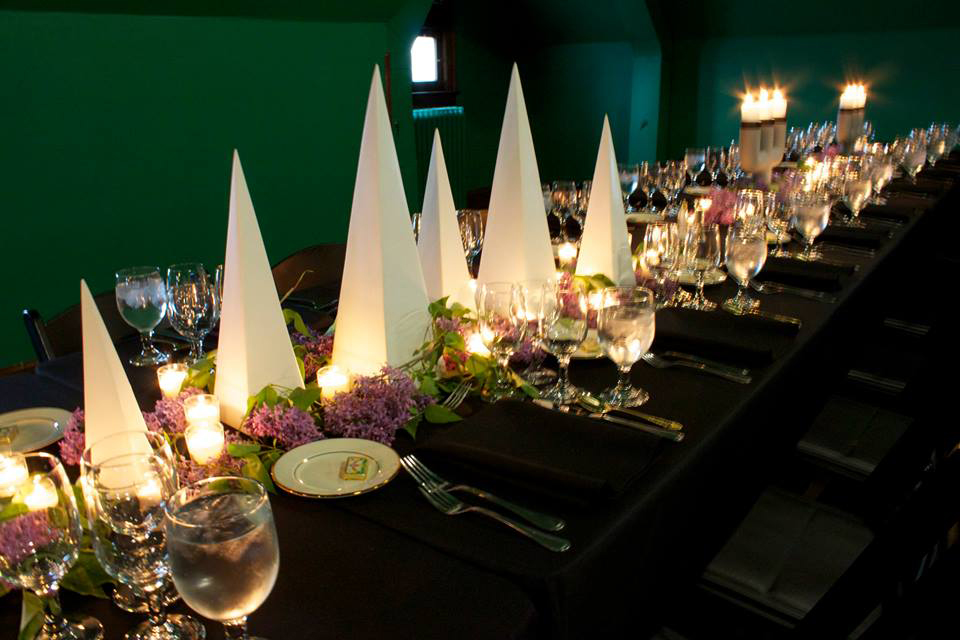
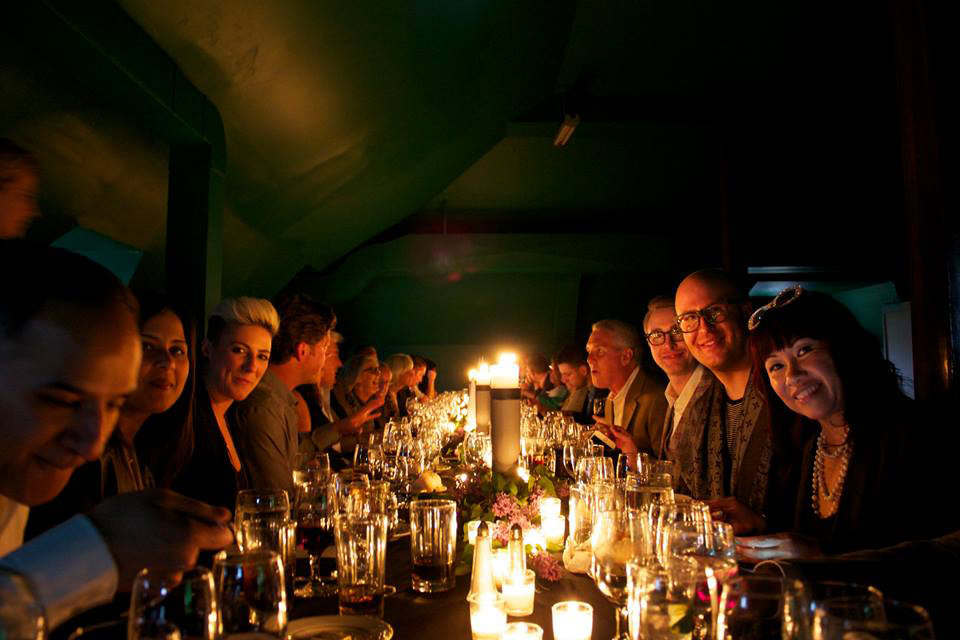
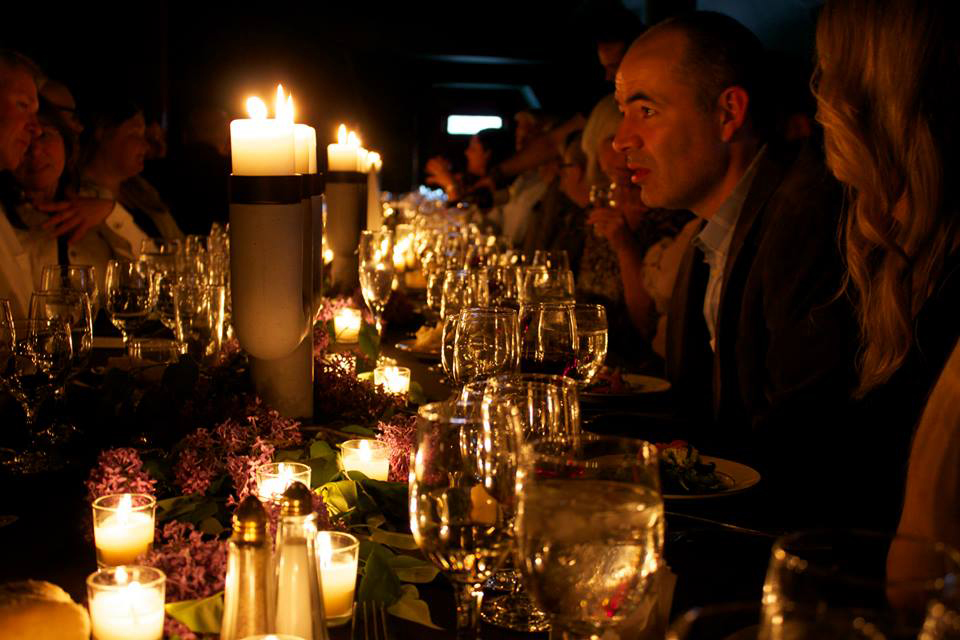
Last September the Stubergs hosted their son, Nick’s wedding rehearsal dinner, where 100 people sat comfortably and were served tacos and other Mexican fare. What a joyous occasion. The ballroom was decked out in a clean, colorful Mexican theme, in keeping with the young couple’s engagement and wedding plans. I was so pleased to hear that the Storz Ballroom had been enchanting new guests in recent years. Rhonda shared these pre-party photos from that special family gathering.
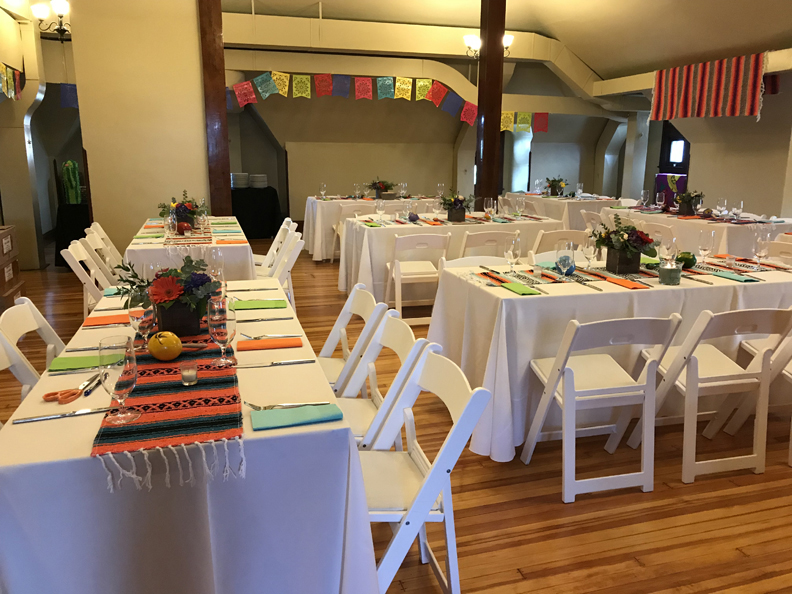

The Adele and Fred Astaire Story
As for these rumors that Adele and Fred Astaire had launched their dancing careers in the Storz Ballroom, the Stubergs have yet to find proof of this story. From what I had found to that point in the investigation, Art Storz, Jr. announced to the press he would name his family’s dancing hall the Adele and Fred Astaire Ballroom back in 1989. There seemed to be some connection that Astaire’s father had worked for the Storz Brewery and also rumor that Fred Astaire would later advertise for Storz Brewery Company but there was no evidence to the children having danced in that lovely third floor room. Rhonda shared that subsequent to buying the home, she was contacted by the BBC, who were making a documentary about Fred Astaire. They had come across the tale of the Storz Ballroom and were calling to confirm, as they hoped to film the legendary dancing hall. When Rhonda shared the news that there was no proof of the Astaires having danced in their third floor space, the film crew still came out to interview them. Ultimately it would appear that the BBC crew was also unable to substantiate the dancing duo having moved across that pinewood floor, as the Storz Mansion didn’t make the cut in the final documentary. I gave my amateur detective’s oath that I would continue on the Astaire Trail.
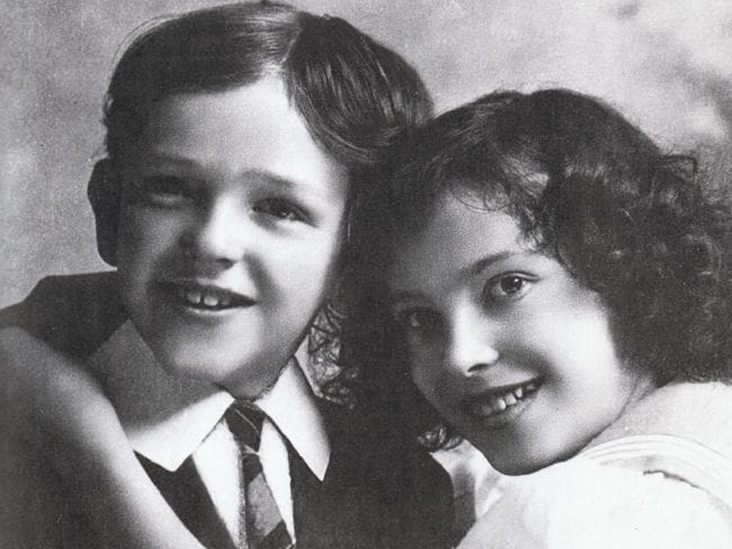
Fred and Adele Astaire in 1910.
If you would like to know more about the Storz family history and how they used their ballroom, continue this way. But for those that require a short intermission, this would be a mighty fine time for a drink refresher.
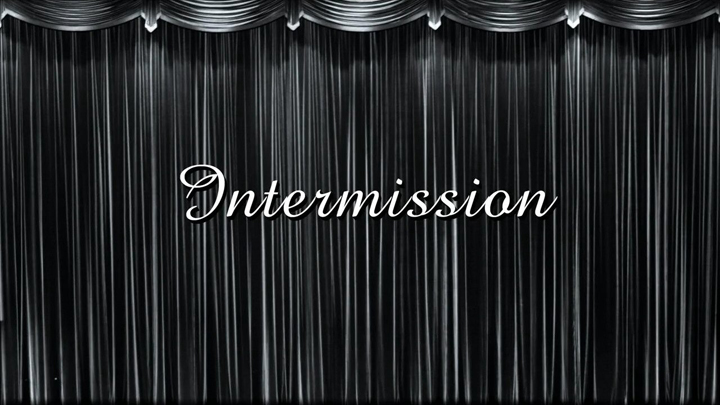
A Brief History of the Storz Family
Mr. Gottlieb Storz was born in Benningen am Neckar in Baden-Württemberg in Germany in 1852, immigrating to America in 1872. Reportedly Mr. Storz became a formal brew master in 1873, although not yet living in Omaha. Storz was known to say he learned his trade in “the old country”. He came to Omaha by way of St. Louis in May of 1876. I would find his Nebraska marriage license dated February 1882 to a Minna (later referred to as Minnie) Buck. Some say she was a widow. Likewise Minnie was born in Germany and came to Omaha in 1881. Approximately ten years younger than Gottlieb, Miss Minnie would give birth to their first child, another Minnie Storz in 1882. From what I could dig up, the couple had six biological children and two adopted daughters.
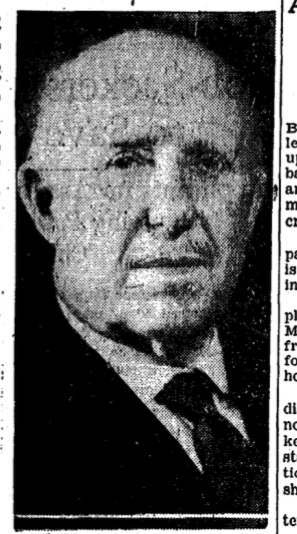
Older photo of Gottlieb Storz borrowed from the Omaha World Herald.
The United States Census of 1900 revealed the Storz family originally resided at 2007 Sherman Avenue, which later became 2007 North 16th Street. From the American Guide Series Omaha: A Guide to the City and Environs from the Works Progress Administration, Sherman Avenue was paved with asphalt in about 1885 and “became one of the fashionable drives of the city. There used to be many mansions along Sherman Avenue.” Although I cannot attest to its mansion status, 2007 Sherman Avenue would later be described as a large, 12-room house framed by a stately stone fence. Oak floors throughout, a library and a “good hot water heating plant”. Multiple bathrooms, large basement with a drying room, garage, beautiful, large grounds with mature trees, flowers, chicken yard and chicken sheds. Chances are this was one of those proper, glorious homes that once dotted the grand Sherman Avenue.
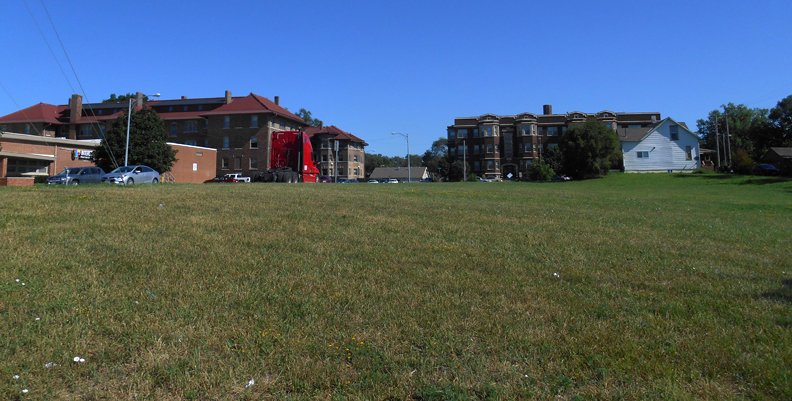
Site of the original Storz home at 2007 North 16th Street. Now an empty field, the Storz’s large home was just north of Grace Street and the Storz Brewery. Photographer is facing north. 16th Street is to the left. The historic Strehlow Apartments, now renamed Ernie Chamber Court at 2014 North 16th seen on the left side of the photo and the Margaret Apartments (2103 North 16th) on the right, parallel with Yates Street. Upon deeper review of census data, I was very interested to bump into the Thomas and Ada Dennison family, close neighbors to the Storzes, just around the corner at 1507 Yates Street. Tom Dennison was an early Omaha political boss and racketeer, known for his reign over prostitution, gambling and bootlegging in the 1920s. I have made mention of Dennison before, most recently in the https://myomahaobsession.com/2019/07/01/mysteries-of-omaha-312-south-70th-avenue/ article. The 1900 census revealed a daughter Frances and son Thomas lived in the home, along with cousin Rose Hailey.
At the time of the 1900 Census, Gottlieb Storz was 48 years of age.
Minnie, his wife was age 37.
It appears that daughter Minnie Louise Storz Higgins was already married and out of the house.
Adolph G. was then 15.
Arthur Charles was age 11 but curiously documented as “Otto”.
Daughter Olga was then seven.
Louis Harry was 5
Robert Herman was 1
Bertha Cohrs servant 21
Lena Cohrs servant 16
Gottlieb and Minnie would also informally adopt daughters, (who were nieces), Mrs. Earl Buck and Miss Elsie Julia Shippwright. The latter would change her name to Elsie Storz in 1920. I realize I am getting all buried in these details but it is fun for me and it also establishes the family members, which will become important when imagining the ballroom.
A Very Short History of Storz Brewery
We can’t climb to very far up the Storz family tree without establishing the importance of Gottlieb’s brewing empire. A reminder would be discovery of the original family home on Sherman Avenue—just north of the Storz plant, at 1819 North 16th Street. (Again Sherman Avenue and 16th Street are one and the same.)
An early article described the Storz Brewery as a “handsome towering plant on Sherman Avenue” extending from Clark to Grace Streets. Founded as a little ale brewery “back in the trees across the street from the present plant” in 1863 by one Ebenezer Dallow, the ale enterprise was later acquired by Joseph Baumann and converted into a beer brewery. In 1876 Gottlieb Storz, then a young German brewer, became foreman of the Baumann brewery. Apparently Mr. Baumann died that year and Mrs. Baumann would take the helm for the following eight years. Our man Storz continued as brew master. Mr. Storz and Joseph D. Iler would then form Storz & Iler, taking over the Baumann plant lease for ten years. I found a snippet of a mention from January of 1889 where J. D. Iler sold his interest in Storz & Iler venture. By 1891 Storz had organized the Omaha Brewing Association and began building a huge complex, just south of his family home on Sherman Avenue.
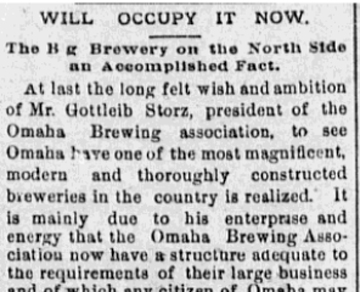
OWH article from December of 1893.
It wasn’t until December of 1893 when the Omaha Brewing Association plant was completed; the brewery land was excavated under horrific condition in what was considered “Arctic Weather” in the year proceeding. The main building was said to be six stories high and in its heyday, the 15 building facility was built out to the envelope for blocks along the Sherman frontage. 1901 the company reincorporated, changing the name to Storz Brewing Company.
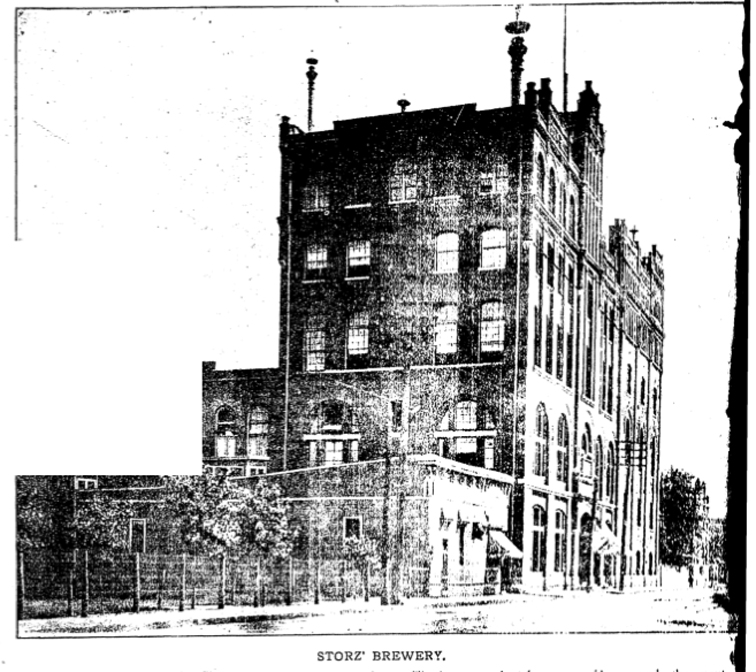
Storz Brewery (1819 North 16th Street) 1907 photo borrowed from OWH.

Postcard borrowed from Cardcow.com. “A busy corner in our bottling department. Capacity, 144 bottles Storz Triumph Beer per minute; 86,400 bottles per day. Stroz Brewing Company, Omaha.”

My absolute favorite. A 1904 Storz advertisement for their Blue Ribbon hit an all-time high by Miss Cassette’s estimation. Hand drawn perfection. Storz was known for anticipating the demand for “high grade bottled beer” resulting in his famous “Blue Ribbon” brand. By 1907 Storz beer was touted to help a man gain weight and balance his nerves!
My recent reconnaissance mission to survey what remains of the Storz plant at 1819 North 16th Street.

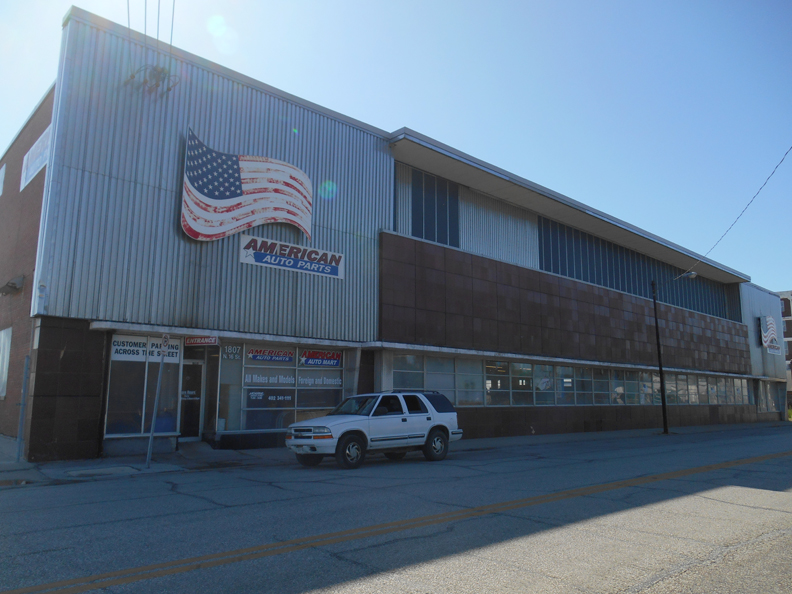

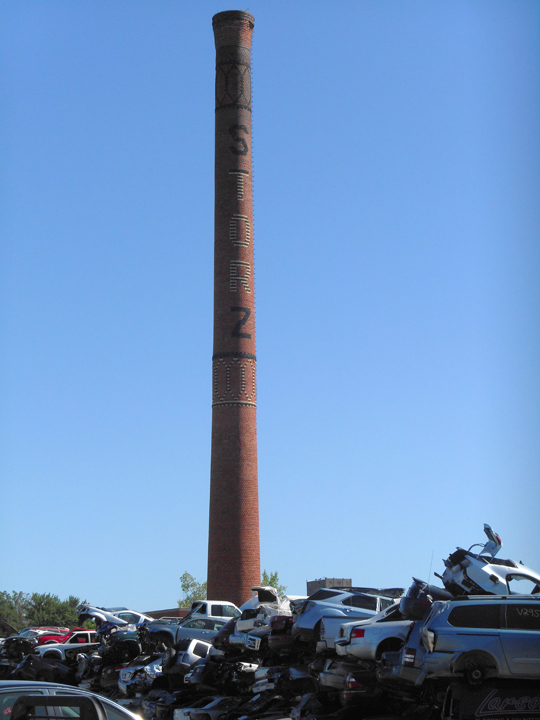
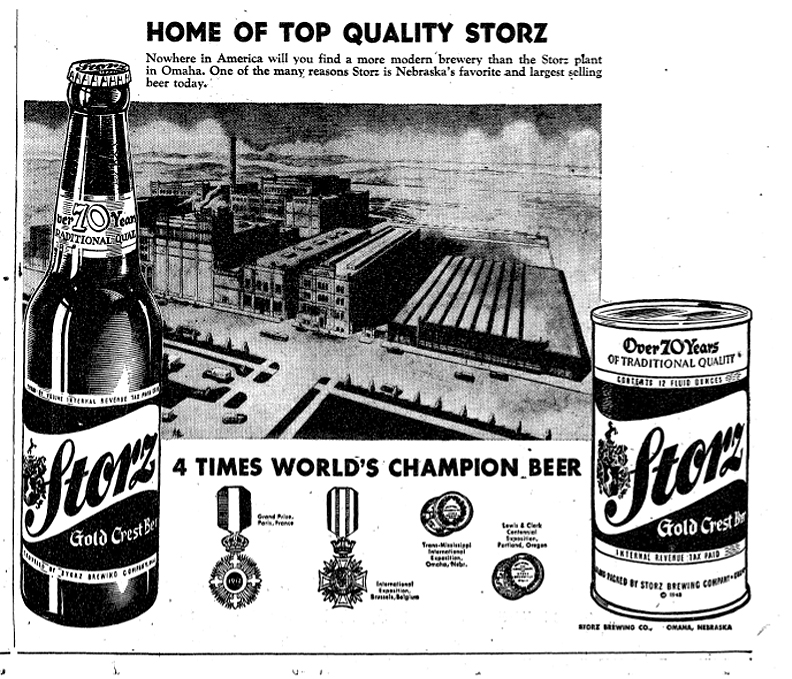
OWH advertisement from October of 1949, to show the once great Storz plant.
Storz beer became one of the most popular beers in the area, accounting for more than half the beer consumed in Nebraska. Gottlieb Storz became a very wealthy man and employed a lot of Omahans, along with Metz and Krug Breweries. This is just a small taste of the Storz legacy and I really must end this now or I’ll get all goofy. Until my big investigation… did you know that Storz Brewery was back in business for a time? Check them out at https://storzbrewing.com/
3708 Farnam Street
I would track the real estate movements of Gottlieb Storz to 1889 when he began buying up quite a bit of property all over town. But it was the announcement from November of 1904 that particularly interested me. In that month Storz acquired four lots on the northwest corner of 37th and Farnam. “Three of lots with frontage on Farnam were sold by Mrs. John A. McShane for $8,000. Behind them, fronting on 37th was a fourth lot, bought for $1,900.”
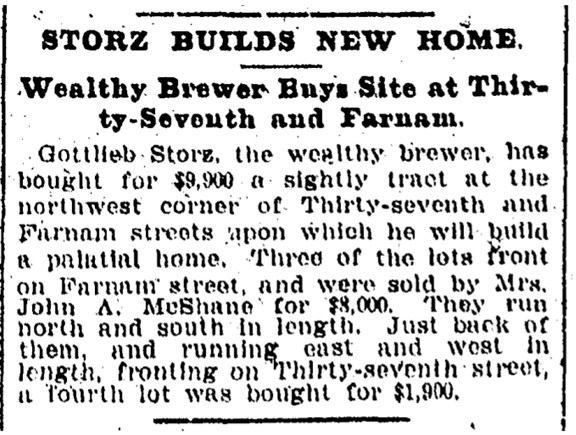
Image from OWH November 1904. Now I’m not exactly sure but I think the McShanes owned a lot of the early Gold Coast and made their fortune in the packing plant business. I will look into this and get back. Let it be known this was a good chunk of change for undeveloped lots in those days but seeing as the Storz social trajectory was escalating, the family understandably had eyes on the West Farnam neighborhood. Additionally Minnie probably was becoming less keen on living next door to her husband’s ever-swelling brewing empire. Just a guess. According to some books and journalists, Fisher and Lawrie Architects were selected for the design of the stately Storz residence, specifically George Less Fisher. Oddly other books and news articles credit my architectural crush, Thomas Kimball with the Storz Mansion.
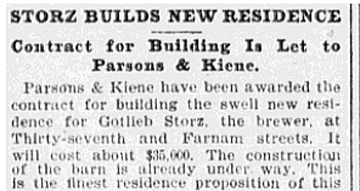
One thing is for sure, the Storzes would announce the builder of their fine home in July of 1905: Parsons & Kiene. A month later a building permit for a $5,000 brick barn on the Storz estate was filed. Was that the coach house I had toured with Art Storz, Jr.? That was a pretty hefty price tag. $5,000 in 1905 is estimated to be about $144,000.00 in 2019.

From an article called, “Partial list of building permits” from May of 1906. “Residence of Gottlieb Storz on West Farnam. A Magnificent Home, Just Being Completed.” Along with the architect, there also seems to be quite a bit of confusion about the home’s completion date. Some writers say 1905, 1906 or 1907. This OWH article hopefully clarifies the mystery. According to B. F. Sylvester’s West Farnam Story, the custom with these solidly built superstructures was “to lay the foundation in the fall, with the floor covered by a foot of straw and let it settle all winter.” This practice, as well as the rumor that German craftsman were brought in by Storz might explain the extended timeline. As to when the family moved in? I wouldn’t find solid proof of ballroom dancing parties until 1907.
Described as Jacobethan Revival, 3708 Farnam remains one of our most impressive and lasting ties to the Old Omaha Gold Coast. The Storz choice of the Jacobethan Revival style is a confident, interesting selection– popular between 1890 and 1915. I have seen other photos of Gold Coast homes, now razed, that looked very similar without its entry and solarium. Featuring pale brick and carved limestone trim, the steeply pitched, red tile roof and equally steep parapeted gables are the striking standouts for me. 3708 Farnam is at once impressive and intimidating. Unlike contemporary homes, which appear to put a premium on multiple garages, the deep, arched entry porch of the Storz Mansion signals a proper architectural introduction. The porte-cochere imitates the proud entry. I could go on and on but I was trying for restraint as I recall. Please drive by immediately.

The mansion of Gottlieb Storz at 3708 Farnam St. Creator: Bostwick, Louis (1868-1943) and Frohardt, Homer (1885-1972). Publisher: The Durham Museum. Date: 1911
The Storz Social Whirl
Omaha writers and journalists of the past have claimed the mansion’s heyday was the mid-20th century when Arthur Storz, Sr., owned the home. It is true, the residence was once the scene of an opulent party celebrating the movie Strategic Air Command in 1955. “The movie premiere was held in Omaha and the premiere party was held at the Storz mansion with guests including Jimmy Stewart and June Allyson, as well as the Strategic Air Command Commander Curtis LeMay.” I am quite sure Art Storz, Sr. entertained on a regular basis and the home was positively backdrop to many other beau monde events.

Looking west down Farnam Street, most likely taken from the Blackstone Hotel. One can see the changing neighborhood, becoming more commercial. The Storz Mansion is seen on the right. Creator: Savage, John (1903-1989). Publisher: The Durham Museum. Date: 1949.
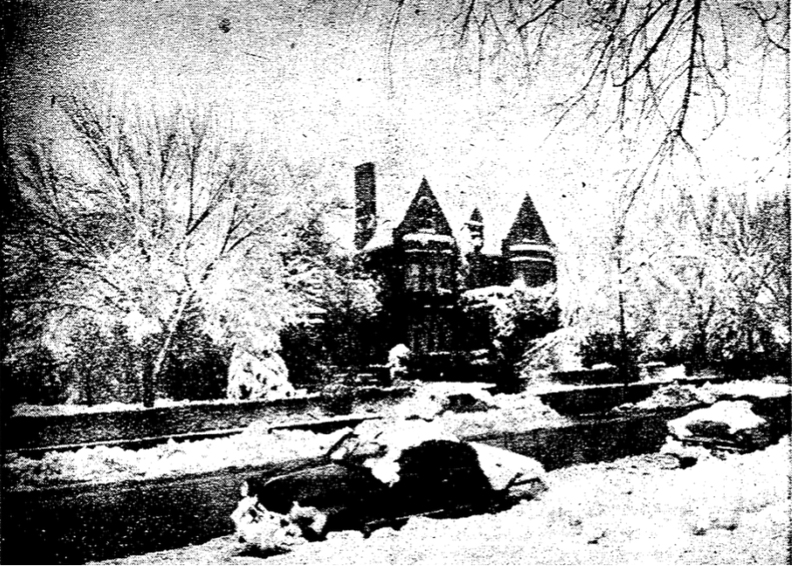
OWH 1950 image of the Storz Mansion, obviously taken during one of our wonderful winterland days. I could stare at this one all of August.
I submit that The Ballroom’s true heyday came much earlier. I base this on the simple fact that private dancing parties were Tres Chic amongst the wealthy of the Edwardian period. By the time son Art Storz, Sr. took ownership (1939), beautiful people parties were often thrown at hotels and had become more of an outward spectacle, even in little Omaha. It would be hard to imagine a private ballroom being employed more than the years spanning 1907-1939, considering the popularity of formal and informal dancing, bands, notwithstanding the fact that the owner was a beer magnate and had eight socially precocious children.
Ballroom Talk
Soon after the Storz family had moved into 3708 Farnam, their “beautiful ballroom in the West Farnam District” became the haut monde scene for “delightful dancing parties.” The ballroom began garnering attention from the press in 1907.
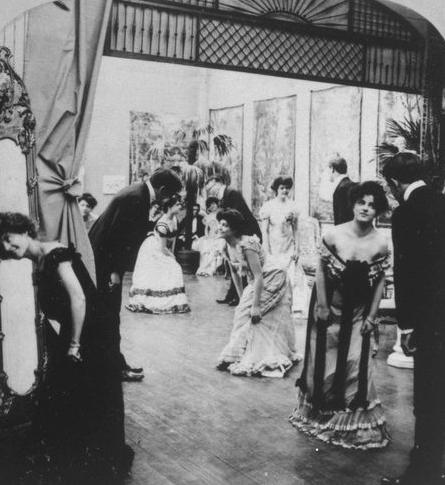
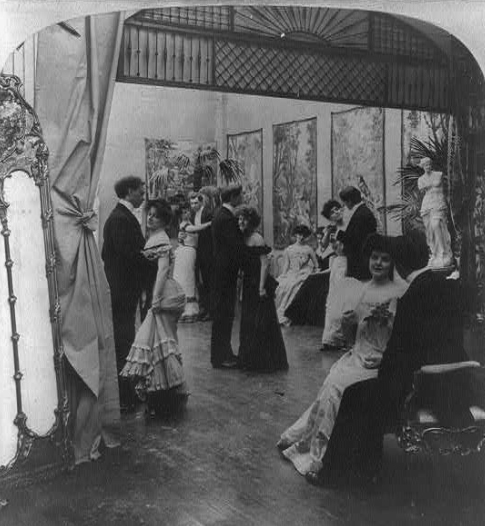
Just to inspire the imagination. 1902 private ballroom party photos from the Gilded Age in NYC.
In February of 1907 Gottlieb and Minnie celebrated with a huge Silver Anniversary party, said to be a great evening of joyousness and festivity. “The Storz (sic) are noted for their hospitality and on this occasion, was most abundantly exemplified. There were many beautiful and valuable remembrances, prodigious piles of flowers, choice regalement and music and song and laughter until well into the night. The ballroom was thrown open and the tripping of the light and fantastic bequited the younger guests until the small hours came creeping in apace. The beautiful home was ornate with fragrant blossoms, cut flowers and altogether the occasion was one of much unalloyed mirth and happiness.” Oh my, what writing. I can see.
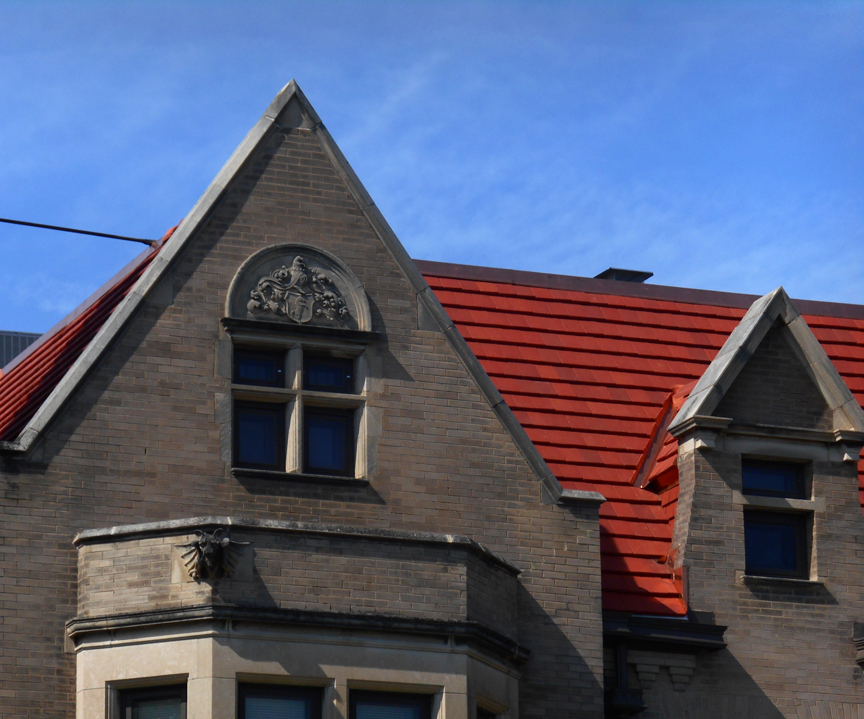
A closer peek at those ballroom windows.
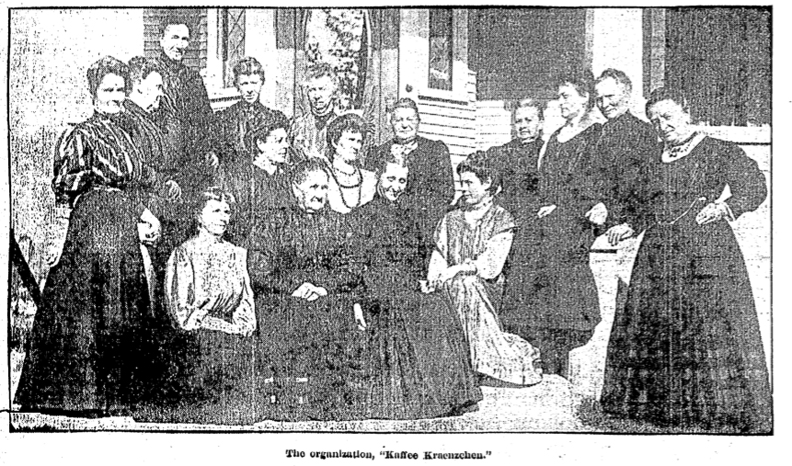
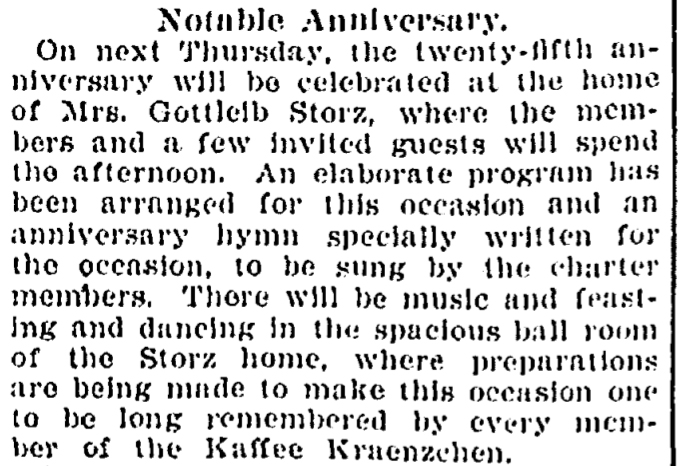
In 1908 Minnie and her German women’s club would have a 25th anniversary party to celebrate their lasting friendship. Thought to be the oldest club in Omaha, the twenty-member society was called the Kaffee Kraenzchen. They had apparently met every two weeks for coffee talk, firmly keeping the membership at twenty. As charter members died or moved away, their daughters would often join the ranks. Minnie Storz was not an original member but probably a good solid pick as she had the mansion and all. On this happy occasion there was to be a dance at the Storz ballroom with live music.
The Society Pages buzzed about the “large affairs” on “Farnam Hill” where I would find the phrasing of “dancing parties” given by the Storz parents, explained in strange and fantastic sentences: “A select group of young eligibles and their ladies got bids to a dance at the Gottlieb Storz home, given for their son and daughter, Robert and Elsie.” Or “a large affair of the last week was the dancing party…the ballroom had decoration of smilax and branches of pepper corn.” This is when I began to put together the use of flower arrangement and popular decoration of the times.
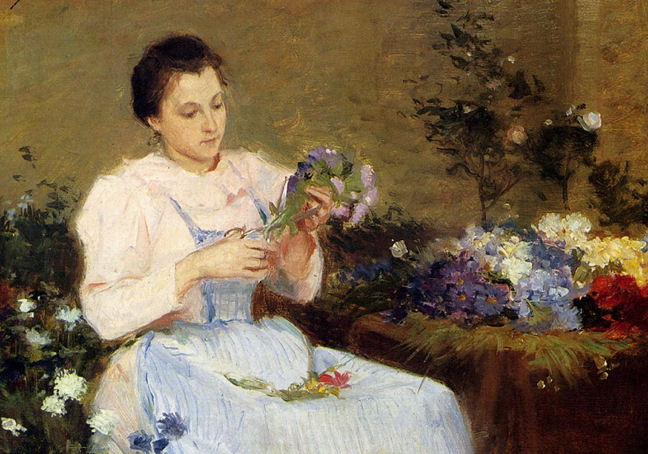
The Proper Decor
From what I unearthed, those who mounted the modest back stairway of the Storz Mansion wouldn’t have needed an escort. They could have been led by the sheer overwhelming scent of fresh cut flowers. I discovered these gracious arrangements of themed décor, interlaced with freshly cut flowers, were immensely fashionable. A hostess and her domestics would tie streamers of tulle all about the ballroom, cunningly hidden in the bolts of tulle were positioned tiny electric lights. Ferns, roses, begonias and azaleas formed the decoration of the proper private ballroom plan in the early years of a Storz party. The best aromatic quote one will ever contemplate: “The flower laden air of the ballroom, one huge chorus of astonishment, that even the breeding of these guests could not suppress, announced to the host that his plans had not miscarried.”
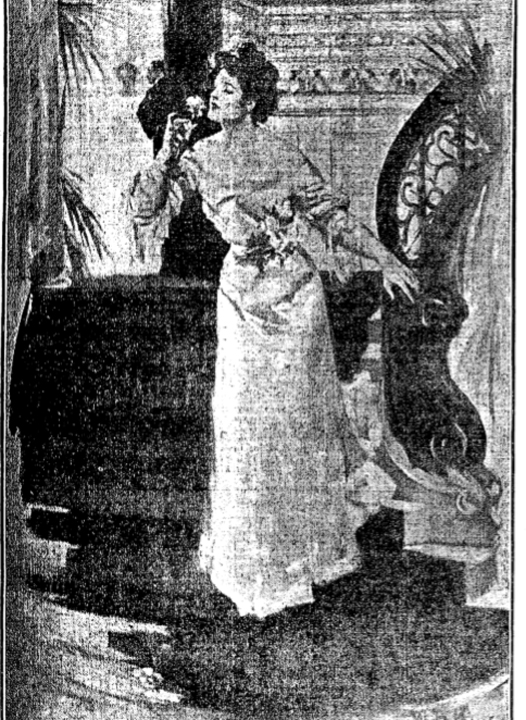
An article from 1907, beautifully exemplified the private, privileged ballroom era. “They all went through the great house and Emily planned a party for every room. There was a perfectly appointed music room and they decided to have out Benthaly and his harp and give a soiree at once. The ballroom was quite made for a Firefly cotillion, to be danced with lowered lights and electrical favors. In the court Toby Beach declared that they might have a wonderful breakfast some noon, with all the fountains playing and a peacock in the little hanging garden. And there must be a field-party. Elinora had never been to a field party? They would put up silk pavilions all over the estate and have an orchestra in the orchard.”
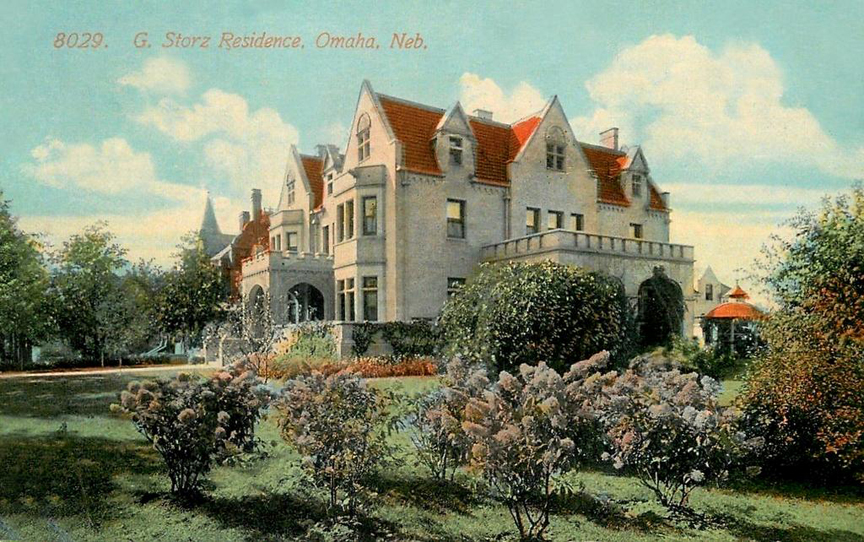
Lovely, lovely postcard of the Storz Mansion.
A World Herald report from July of 1910 puts a finer point on it: “The largest affair of the day will be given this evening by Miss Daphne Peters on 32nd street. Peters has a most beautiful ballroom on the third floor, the scene of delightful informal dancing parties, thought to be infinitely more enjoyable than those given in clubs. A room in a home adapts itself to decoration better than a clubroom and the decorations at home can be more elaborate.”

OWH. 1914. Stroz Holiday party write up in the Society section, featuring list of female guests. Sorry I had to cut off the males.
By the teens, I discovered Society was possibly looking outside of its insular group for other inspiration to draw upon when planning a dance in their home. Japanese lanterns and cherry blossoms were all the rage for private dancing party décor held in third floor ballrooms in these years. In 1912 I found a hostess had planned a Spanish themed dance, introducing “two fancy Spanish square dances such as the Fandango” to be incorporated with a short list of the usual waltzes and two steps. Clothing in the teens had also changed and I discovered the dresses were much more restrained.
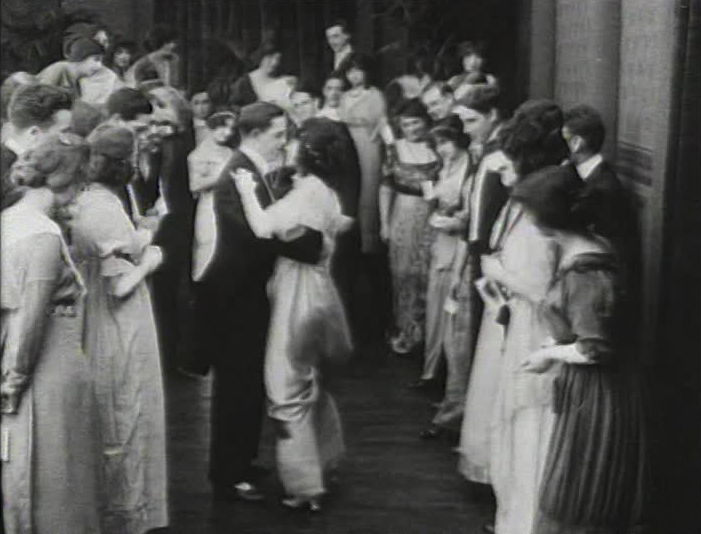
Ballroom party circa 1912.

The Gottlieb Storz Mansion at 3708 Farnam Street. Creator: Bostwick, Louis (1868-1943) and Frohardt, Homer (1885-1972). Publisher: The Durham Museum. Date: 1917.
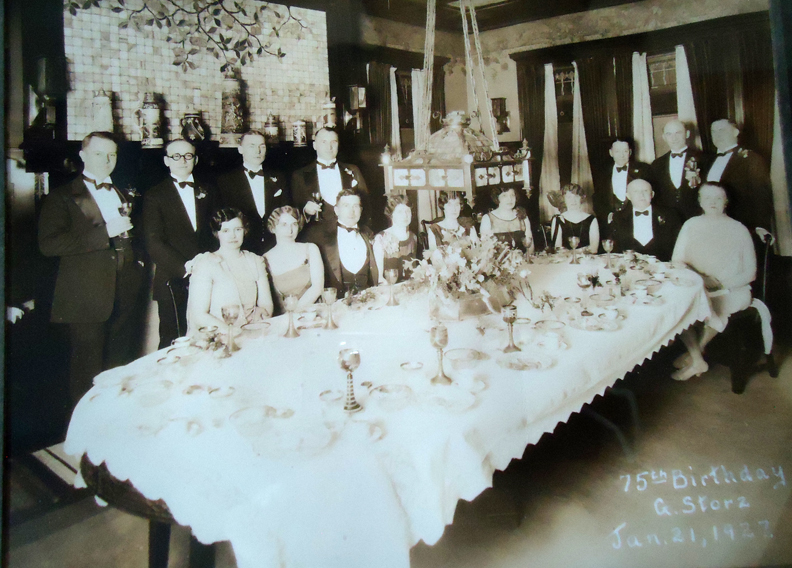
A glorious photograph taken in the Storz Dining Room on the occasion of Gottlieb’s 75th birthday party. June 21, 1927. This really gives me a good shiver. They say that ballroom dancing in the home had fallen from favor but dressing to the nines for a party obviously had not. Now that is a fine looking bunch. From the Rhonda and Wayne Stuberg collection. Thank you for sharing!
The Astaire Mystery Continued
Dear friends, I have to warn you. I am about to get deeply obsessive about this Astaire Ballroom quandary. The following is to be read as a brainstorming session amongst detectives with Miss Cassette thinking aloud.
Gottlieb’s son, Arthur Storz, Sr. and wife Monnie and their son, Arthur, Jr. would buy the Storz Mansion from the estate upon Gottlieb’s death in 1939. After his mother’s death, Art, Jr. would then reside in the home. It was in 1989 that Art, Jr. announced to the press that he would name his family’s third floor dancing hall, the Adele and Fred Astaire Ballroom “in honor of the Omaha sister and brother who, as children, danced there. Fred Astaire approved the naming before his death,” Storz added, alluding to having checked in with Mr. Astaire for permission. Storz was later quoted to say, “The ballroom was where Adele and Fred Astaire started their illustrious career.” Since then, the Astaire lore has fused itself to the official history of the Storz Mansion and one will find it repeated over and over in almost every document.
It is true the Astaire children, born to Frederic and Ann Austerlitz, were a dancing duo to come out of the Omaha vaudeville scene. I found them dancing at the Boyd and Orpheum Theatres. Back when I wrote about Adelaide Fogg (or was it her sister Ione?) having beaten the Astaires in a dance competition, I came to realize just how long ago Fred had begun his ascension to fame. https://myomahaobsession.com/2016/10/11/the-quest-for-miss-adelaide-fogg/
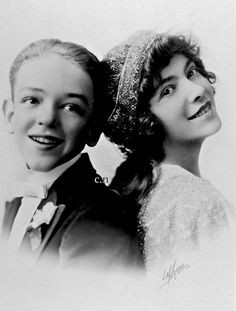
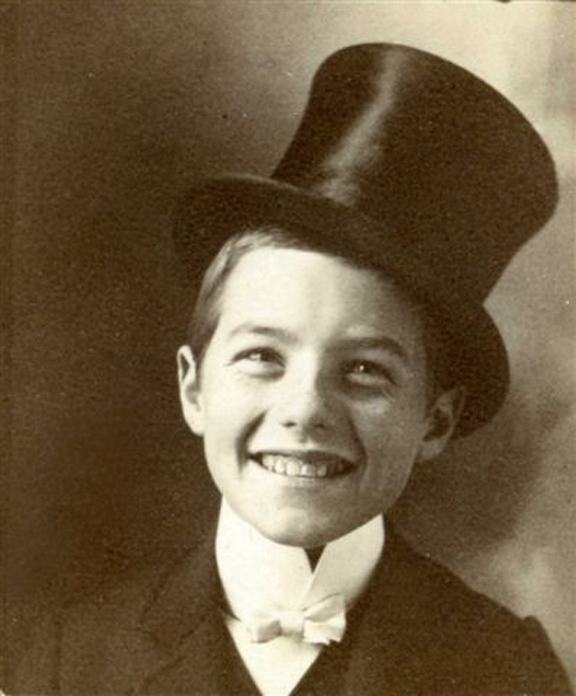
It is said that their father, Frederic Austerlitz, worked at Storz Brewery. At first I was not sure if that link was correct and even so, was that enough to gain invitation to one of Gottlieb Storz’ dancing parties? I would later find clues of Mr. Storz having thrown large ballroom parties where his brewery staff was invited. As it turns out, I found solid evidence of Fred Austerlitz having been a salesman for the brewery, a position that would have garnered him attention from Gottlieb. Austerlitz would remain in Omaha, working for Storz when his family relocated to New York to pursue dancing careers for the children. In poor health, he later moved to New York to be with the family in his last year of life.
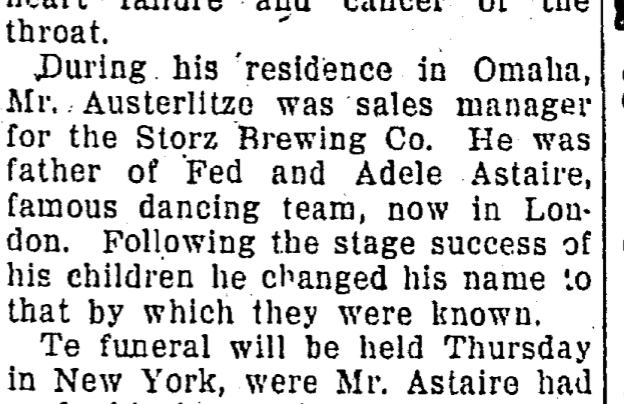
October 1928. Father Frederic Austerlitz passed away. He would become sales manager over time.
For his part, in 1970 Fred Astaire told TV interviewer Dick Cavett that he left Omaha at age four and a half and hadn’t yet learned to dance by the time he moved to New York City. No one in Omaha seemed to like that particular storyline at the time, especially when we consider that BigSmallTown Omaha needs a real life Fred and Adele Astaire now and again. But let me tell you his female grade school classmates really came out of the woodwork to let ‘em have it over that comment. The Astaires were known to have danced at Kellom in different classrooms for entertainment. Of course by 2019, anyone who knew Fred and Adele “back when” at Kellom Elementary have long since passed.
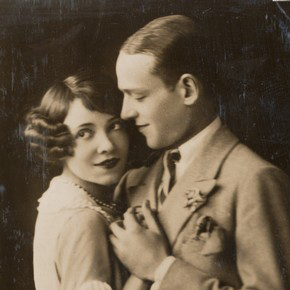
Fred Astaire is commonly thought to have started dancing in Omaha at the age of four but from my investigation, Fred and Adele made their first big splash at an Orpheum tryout in 1908, when Fred was approximately eight. Adele was 18 months older. Soon after their mother took them to New York where they began serious study. Other accounts say the family left town in 1904 and the kids were performing five-a-day vaudeville engagements on the East Coast by 1905. And it was then that they learned the vaudeville routines and joined the Orpheum tour circuit.
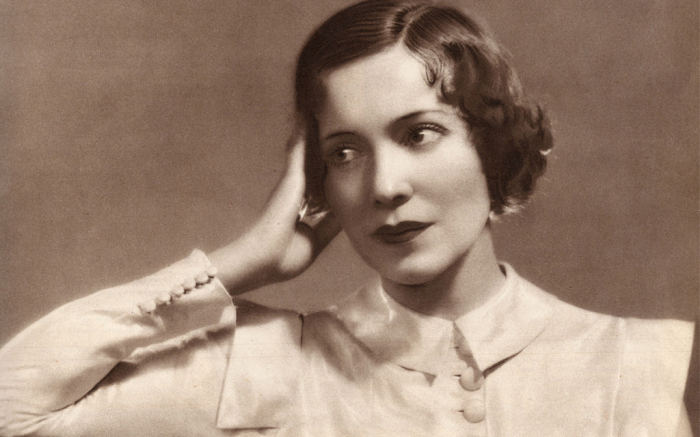
Years later it was stunning 16-year-old Adele who was considered the real standout. A gorgeous girl and a true talent! (Of course I love Fred as well and own a handful of his movies.) It would appear “Omaha’s Brother and Sister,” as they were called back home, had changed their name to Astaire by at least 1912. Rumor has it, the Astaire siblings broke through on Broadway in 1917. Not surprisingly it seems the couple was split up sometime in the early 30s and Fred was later paired with other famous dancing dolls, such as Ginger Rogers. Ultimately Fred Astaire’s name rightfully remained in light while outstanding Adele would fade away from the spotlight (although she married Very Well). Most people, outside of the dance-obsessed-fringe, did not know of her.
I was becoming frustrated with myself when all I could unearth was the international dance and film star having “began his stage career in Omaha,” minus the desirous, quaint anecdotal connection to the Storz Ballroom. Omaha Locals would claim the Astaire kids learned to dance at the Chambers Dancing Academy (I tracked this 25th and Farnam Streets) when they were seven and nine. Adelaide and Ione Fogg began their dancing instruction there as well; it was considered The Best Dance Studio for young up and coming dancers in that era. Now why would it be that everyone in Omaha wanted to pin down the Astaires to Central Time Zone and place, meanwhile Astaires’ various biographies tell a very different tale of an early move to New York and subsequent career? Could it be that the family was traveling back and forth between NYC and Omaha, as was in the Adelaide Fogg case? Or was this a polished historical rewrite to class it up a bit and add more character? I am sure it happens all the time.
Solid Case?
In 1958 Art Storz, Sr. told the World Herald that as a high schooler, it was under the tutelage of Fred Austerlitz that he would learn how to hunt. He described Mr. Austerlitz as the Western Nebraska Storz Beer Salesman. Austerlitz’ s assigned region, west of Grand Island, was best reached by horse and buggy where prairie chickens, quail, ducks and geese were plentiful and firearms made up part of the Storz sales kit. It was under the wing of Austerlitz and on these wild western Nebraska routes that Art, Sr. would learn his passion for the hunt. I found this fascinating. It would appear the Austerlitz connection was more than that of employee. If Gottlieb was sending his boy across the state with Austerlitz, I was getting closer to establishing a true family friendship.
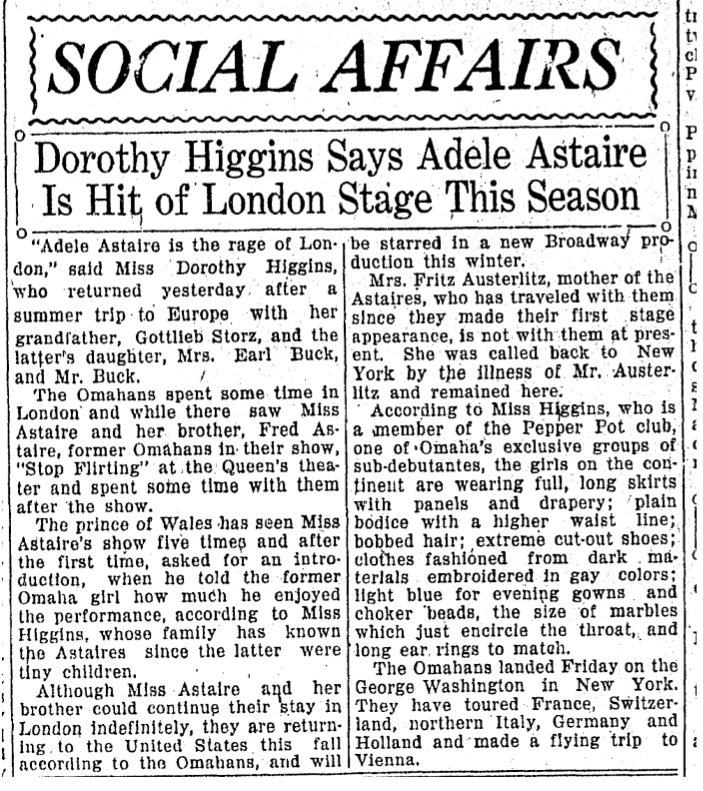
This OWH Aug 1923 article kind of cinched it for me. In it, Storz’ granddaughter, Gottlieb Storz, his adopted daughter and son in law visit the Astaires’ stage show while abroad. While backstage with the stars, no less, granddaughter, Dorothy Higgins makes mention that the Storzes, “whose family has known the Astairs since the latter were tiny children.” Not only were the Storz’ granted admittance to the Astaires’ green room but in conjunction with the comment, it gives further credence to the family ties and the great possibility of the Astairs having visited the mansion.
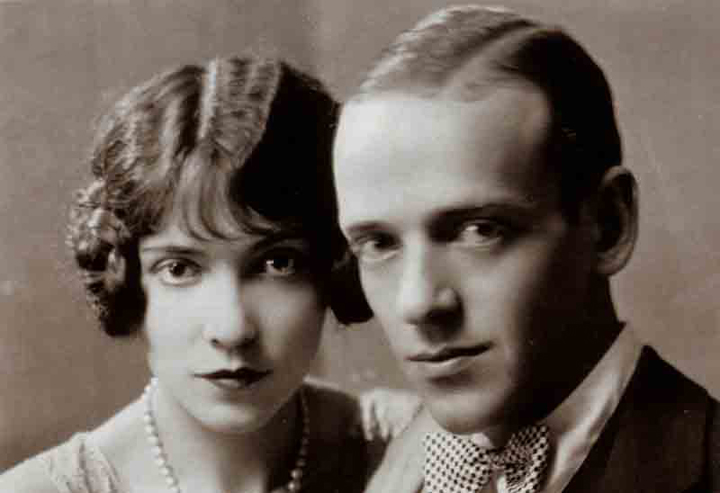
At the time of this posting we still do not have a quote from the Astaires nor do we have a photo of the Astaire children in the Storz Ballroom with a candlestick but the two families were definitely friends. After my detecting missions, I believe the Austerlitzes had most likely attended the Storz’ family parties. I am a believer. As far as kicking off their careers in the ballroom, I have serious doubts. A curious 2005 World Herald article stated, “Omaha native Fred Astaire took dancing lessons in the Storz Mansion at 37th and Farnam Streets.” Now I am not sure where that storyline developed. In all of my research of newspapers and society memoirs, I have found no mention of the ballroom ever being used formally for dance lessons but I suppose it could be possible. A recital? Maybe, but even in that, one would think the Society Press would have been all over it. Typically recitals of music or dance were publicized and seen as a chance for a society woman to shine, especially someone with a ballroom promoting children’s arts.
Ultimately I believe the renaming of the Storz Ballroom was meant as a respectful nod to the Astaires’ humble Omaha beginnings. Respectfully I add, that we must consider the Ballroom was named at a very difficult time in the mansion’s history– when it was feared the family home might be lost to financial difficulties. As if the Storz Mansion wasn’t glorious enough to save on its own merits, it might have been perceived that it needed that extra oomph of celebrity. I cannot ignore that the Astaire Ballroom Lore very possibly grew dancing legs of its own over time. As always, if you know anything about this mystery, please spill the tea.
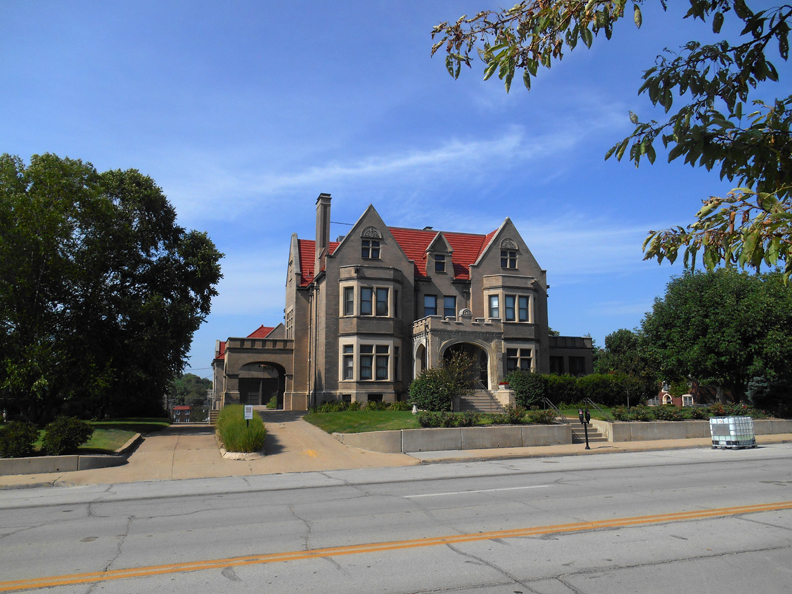
Wow! I have had a real blast with this one. Thank you so much to Rhonda and Wayne Stuberg for their generosity in showing me their gorgeous home but more importantly for their passion and commitment to restoration and conservation. Omaha Needs More Architectural Stewards like the Stubergs. Thanks to the great Storz Family of Omaha and for their contributions in shaping our city. I can’t wait for the big story. If you happen to have a top floor ballroom in your home, I would love to hear from you. Please make contact at myomahaobsession.com. I ask for your patience as it takes me a long time to get through all of my email. For the rest of my super sleuth friends and newcomers too: keep looking up for those top floor ballrooms. Proper ceiling height, proper pitch, good windows. I know you will find them. Thank you!
This is only a small part of the Storz Ballroom history. We would all love to hear your stories of the Storz Brewery, the family, the Gold Coast, Old Money Omaha, if you hold evidence in the Fred and Adele Astaire storyline, historical insight, opinions or insider clues. Please feel free to leave a memory or thoughts. I believe we know more together. Thank you, Omaha Friends.
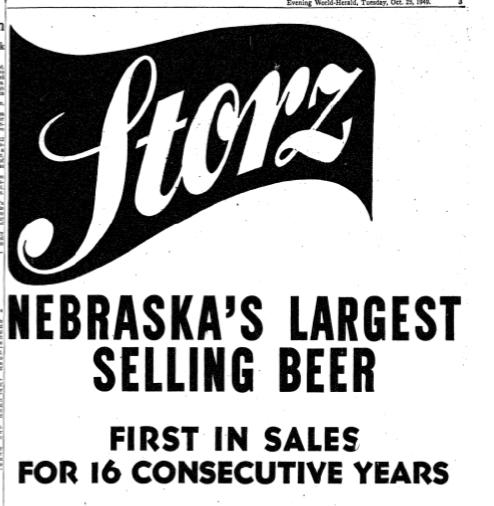
You can keep up with my latest investigations by joining my email group. Click on “Contact” then look for “Sign me up for the Newsletter!” Enter your email address. It will then display “Thank you, your sign-up request was successful!” Make sure to check your email address to confirm. You will get sent email updates every time I have written a new article. Also feel free to join My Omaha Obsession on Facebook. Thank you, Omaha friends. Miss Cassette
© Miss Cassette and myomahaobsession, 2019. Unauthorized use and/or duplication of this material without express and written permission from this site’s author and/or owner is strictly prohibited. Excerpts and links may be used, provided that full and clear credit is given to Miss Cassette and myomahaobsession with appropriate and specific direction to the original content.
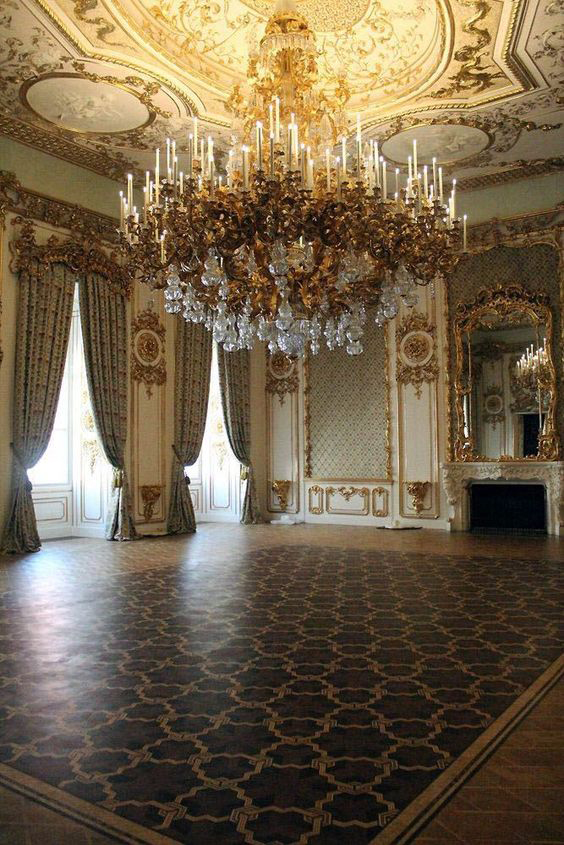
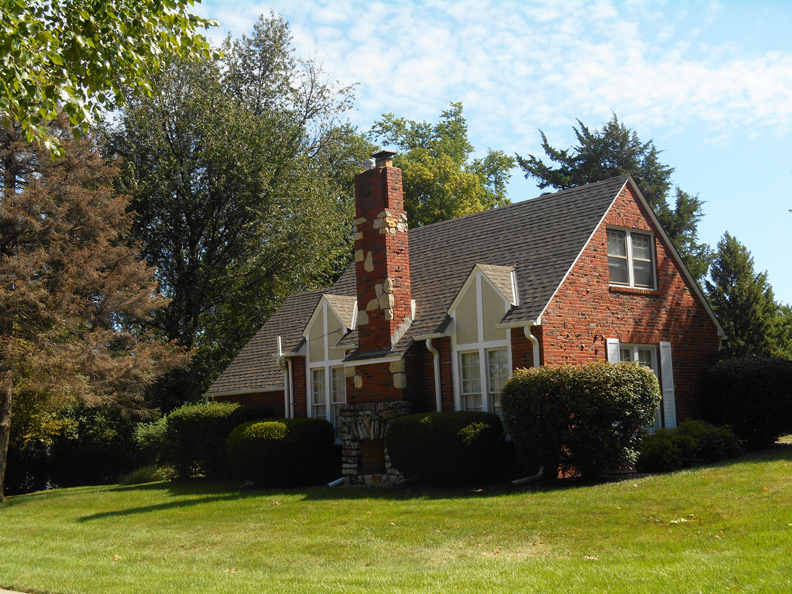

I have to think you’re familiar with the mansion built for daughter Millie on 38th and Dewey. I ran a catering business there for a brief period, when it was rejuvenated and called The Renaissance Mansion. I don’t know how the house has fared since then, but it was awash in the delicious woodwork and fixtures typical of the era. I fondly recall the hand-painted mural above the deep mahogany wainscoating in the dining room. I also have hoarded a small piece of the wondrous, copper/gold wallpaper, now long gone, from the main living room. I particularly love the place because I married my Beloved there. Alas, it’s no longer open to the public. I wonder if Millie’s ghost still makes her presence known…
Thank you for this wonderful article! Love how your mind works!
My family was part sponsored by Arthur C. Storz Sr,.(along with General Lauris Norstad) in immigrating to America. My parents, my baby sister and I, moved from Fontainebleau , France,where my father was the butler for General Norstad….he managed the household (Downton Abby style)e and we lived in a carriage house. It was hot and humid, and long after midnight, when Mr. Arthur C. Storz,, all by himself, picked us up from the Union Station on July of 1953. He drove us to our first home in America,,,the carriage house at 3708 Farnam Street. We actually lived over the garage. I attended Columbian grade school. Some of my girlfriends lived in these glorious mansions. Arthur Storz Sr.came across fairly stern, but he took the time to show me a twelve year old, how to plant Nasturtium Seeds in a flat. The street cars on Farnam Street were still operating and how much fun it was riding them downtown. The Storz cook Gunther was a friend from Germany. He and my dad worked for the Allied Generals after WW II. in Wiesbaden Germany. General Curtis LeMay, Commander of SAC Air Force Base was the reason we all ended up in Omaha. A long story.. Fast forward…my dad Henry Hofmann worked for the Storz Brewing Company and ran the Trophy room till they closed. Art Jr. and my father were good friends. Many more stories.. My husband and I moved back to Omaha from Whidbey Island WA.last November. We bought a house you’ve written about. Would be interesting to talk to you sometime. Thank you for your amazing sleuthing .
Lovely article! Where do you find those delightful history books like West Farnam Street? Are they available at the library?
Also, you do a fine job conveying the ghastliness and social depravity of wealthy families, particularly those of the Gilded Age. That such hellions would take great pains to conceal their servants from view, so as not to have to acknowledge their humanity, is disgusting.
I loved the story. I had an early ballroom experience from visiting the Dodge House in CB–that is where I first saw a third floor ballroom. Of course the Joslyns has the ball room on the third floor, used only twice as reported. One time for the daughter’s coming out party and again at her wedding. The ceiling has been lowered when hvac was installed during the OPS days. On a tour there one day I learned about the pine dance floor. I would point out during the tour that the flooring in the family dwelling was oak and, in part that was how the servant’s quarters could be distinguished as they flooring there was pine. Then I would get to the third floor and say, “Forget what I just said about pine floor. A gentleman said pine makes better dance floors as it is softer and has a little give to it. That floor is beautifully preserved as it appears the Storz one is too.
Delightful story and what a friend you have in Rhonda!
Wow, what an amazing article! Gottlieb Storz was my great-grandfather and my grandfather, Arthur C, Storz Sr. moved into the house after Gottlieb died.
Thank you for the amazing article. I so enjoyed reading it. I remember driving by the house as a child. The mansions were so beautiful, like looking at art.
I agree, this is an amazing article from our history! Gottlieb’s brother Charles Storz was my great grandfather. Charles youngest son Emil was my grandfather. And Emils youngest daughter Virginia Ann was my mother.
My family is planning our first visit to Omaha this fall . Our goal is to see and learn as much as we can about our Storz history.
My grandpa moved from a mansion on N 33rd St. to another mansion converted into apartments across from the Storz mansion (to the east). There was an older lady who lived on the main floor whom had her apartment decorated like “old Hollywood”. The way she talked and was soo prim and proper was like old Hollywood from the 30’s-40’s. This was back in the mid 80’s so I know she is gone. I’d like to think she was a Hollywood starlet whom moved back after not making it as big. I’d love to know her back story.
Dan
My wife and I were in the Storz mansion several times. We had a German shepherd dog that was very protective of my wife. So protective that we finally had to give him up. Art Storz, Jr., bought “King.” When he came to pick him up, King jumped into the big limo and thought he was moving up in the world. We kept in touch with Art and visited him at the mansion several times for an adult beverage or two. He was very nice, very proper, but a little eccentric Unfortunately he never showed us the ballroom
I met Rhonda’s husband one time when he was working at the UNMC. We talked for a short while and he told me what they were doing to remodel and upgrade the mansion.
By-the-way, a mansion you might want to look into some day is the mansion where Heafey and Heafey had their funeral business before moving out the West Center. It sat on the corner of 35th & Farnam were the Security National Bank is located. I was in that mansion numerous times after the mortuary moved and it was for sale. Mickey Landon bought it and was going to tear it down. It was such a beautiful mansion that several of us wanted to see if we it could be moved, which would have been quite a feat if it could be done. Of course, it took quite some time trying to figure out if it could be moved and then where would we move it to. Mickey couldn’t wait for our decision and tore it down. It had a very large ballroom on the third floor.
Hello Frank–King must have thought he was getting his namesake due! I am glad he found a good home in Art. I love that you mention the Heafey and Heafey house on Farnam. I do have wonderful box of treasures that another reader sent to me from that house when it was for sale and around that time. Some day I will scan all of those images and get to it! When I begin work on that story I must get in contact with you to flesh out the story.Thanks for your great addition to this story.
There is a big difference in a finished attic and a ballroom. Most of what are presented here are just finished attics.
I purchased lots of furniture from Scotty’s Sales in Council Bluffs Iowa when I was in the Air Force stationed at Offutt AFB. My purchases in Omaha dictated the size of my future homes in both MA and AZ. I still have beautiful stuff from the Storz Mansion. One of the homes I owned in MA was a 5,000+ SF semi-mansion with carriage house that had a third floor that we called the ballroom as it had finished pine floors but was otherwise unadorned except for the dormers and decorative windows.
Yummy! I love to dream about this home you described and all of this great furniture from CB, IA that has traveled with you. Thank you!
Are you aware of any ballrooms that had “sprung” dance floors?
Was able to check out the ballroom on a Historical Walking Tour in summer/fall of 2022! So amazing. My father worked at the Blackstone when it was an office building for some 19-22 years? I loved seeing the white house that was a Frat house, but I also remember when they tore that down. Hope I see the house owned by a Mr. Maser ( i think his mother’s trust truly owns it) but my gosh, what a wonderful home. Thank you!!